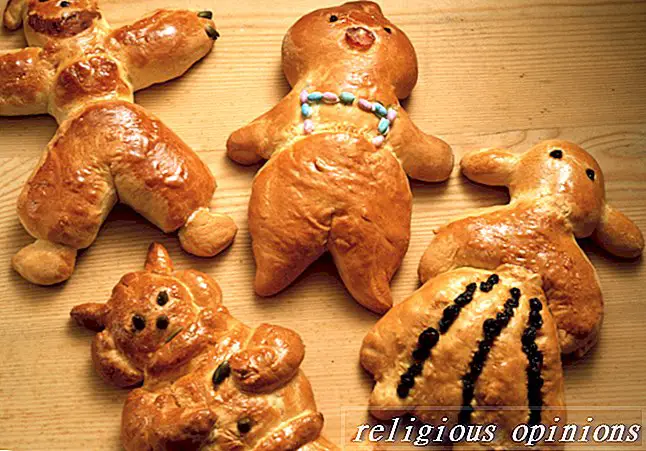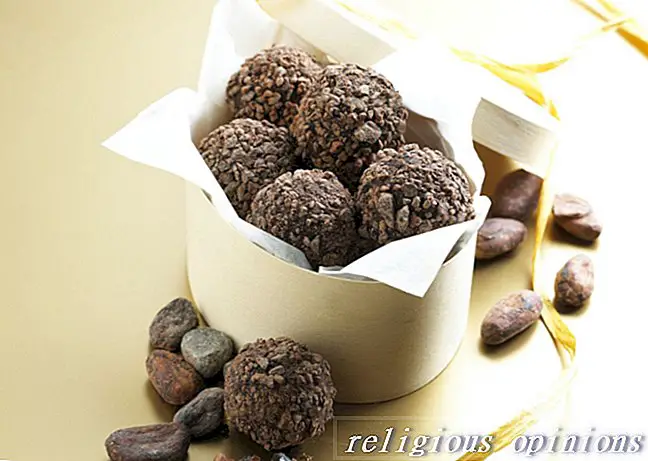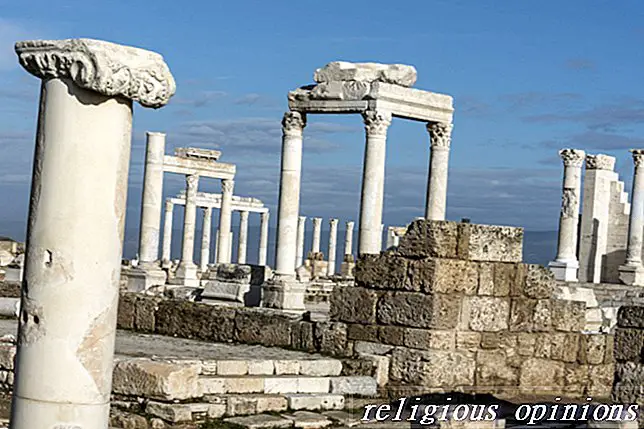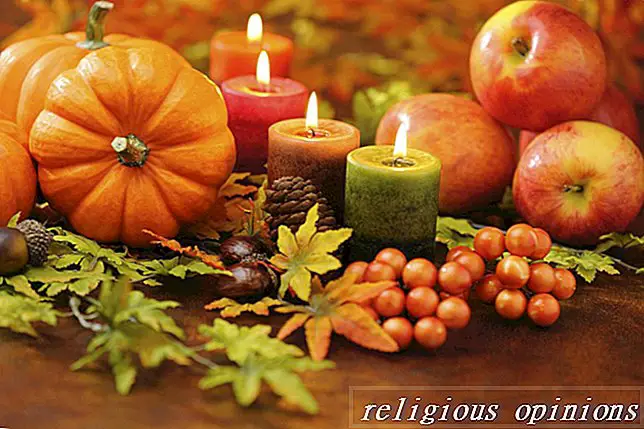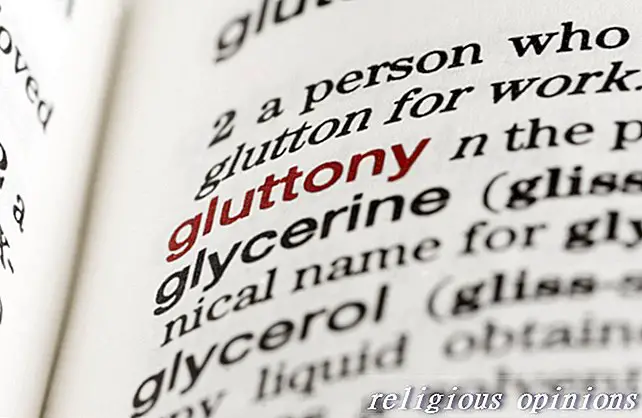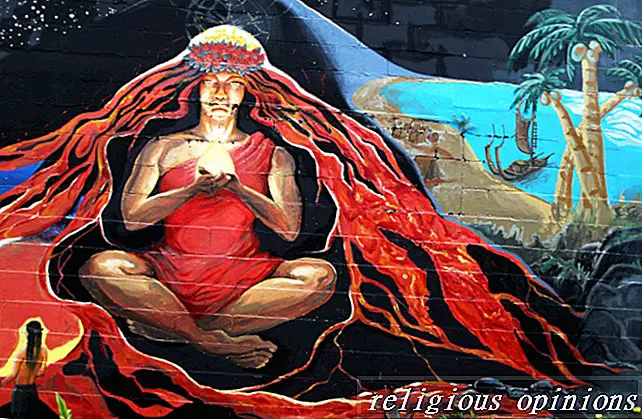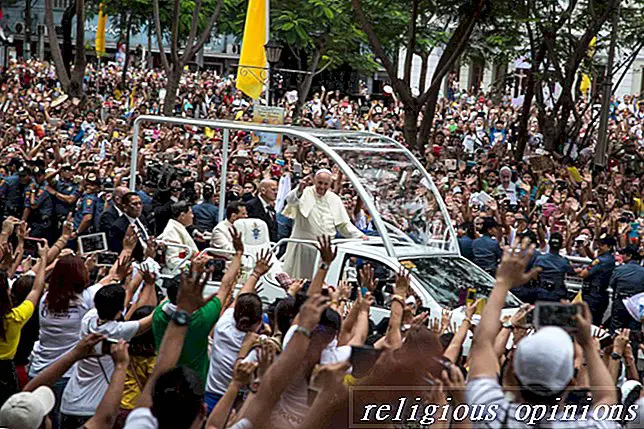Skrypt Gurmukhi z Gurbani zawierał 35 akhar, czyli spółgłosek, identyczny z pendżabskim alfabetem malarskim, w tym trzy uchwyty samogłosek i 32 spółgłosek. Każda postać reprezentuje dźwięk fonetyczny. Kolejność alfabetyczna pisma Gurmukhi jest całkowicie inna niż alfabetu angielskiego. Gurmukhi akhar opiera się na grupach mających pewne podobieństwa i jest ułożony w siatkę pięciu poziomych i siedmiu pionowych rzędów o określonych właściwościach wymowy (których nie pokazano tutaj). Każda litera ma kombinację cech w zależności od jej położenia poziomego i pionowego. Niektóre litery są wymawiane z językiem dotykającym grzbietu górnych zębów lub zwiniętym do tyłu, aby dotknąć tuż za grzbietem na dachu ust. Litery mogą być wymawiane za pomocą zaciągnięcia się powietrzem lub mogą wymagać zatrzymywania powietrza. Niektóre postacie mają dźwięk nosowy.
Wersety Gurbani mają duchowe znaczenie w pismach sikhijskich i zawierają metaforyczne fragmenty, w których figurują różne litery Gurmukhi. Pisownia fonetyczna liter w tłumaczeniach jest różna.
01 z 36Przewodnik wymowy Gurmukhi Oorraa
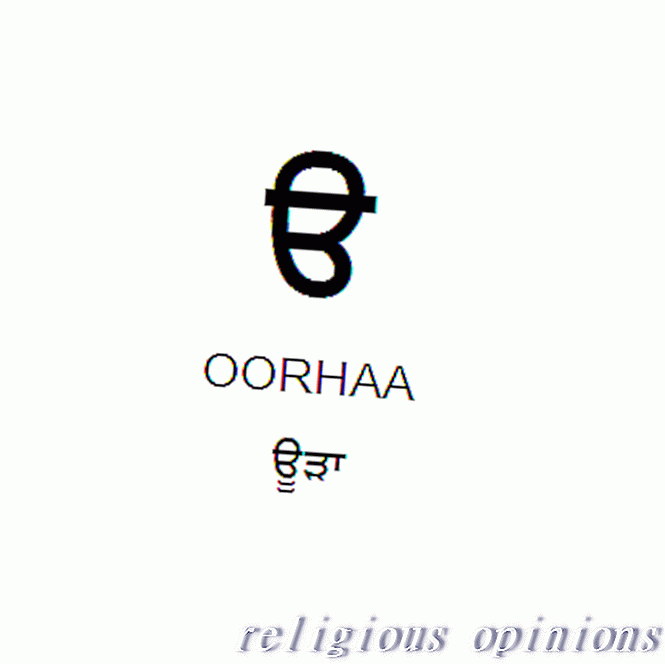 Pendżabski Akhar Oorraa z Gurbani Znaczenie w pismach sikhijskich Oorraa Gurmukhi Vowel Holder. Zdjęcie [S Khalsa]
Pendżabski Akhar Oorraa z Gurbani Znaczenie w pismach sikhijskich Oorraa Gurmukhi Vowel Holder. Zdjęcie [S Khalsa] Oorraa jest pierwszym z trzech posiadaczy samogłosek pojawiających się w skrypcie Gurmukhi Gurbani i jest identyczna z posiadaczami samogłosek alfabetu pendżabskiego (akhar).
Oorraa jest wymawiana z równym naciskiem na sylaby i brzmi jak owca surowa. Oorraa jest używana na początku słowa, gdzie pierwszym dźwiękiem jest samogłoska lub w dowolnym słowie, w którym samogłoska nie jest poprzedzona spółgłoską, jak w przypadku dźwięku podwójnej samogłoski i ma przypisane specyficzne dźwięki samogłoski. pisownia Oorraa jest fonetyczna i może również wydawać się pisana jako Oorhaa . Pisownia może się nieznacznie różnić w oryginalnym Gurmukhi, a także w rzymskich i angielskich tłumaczeniach Gurbani.
Znaczenie Oorraa w Piśmie Świętym Sikhów
Pismo sikhijskie obejmuje akrostyczną formę poetyckiego wersetu napisanego przez pierwszego guru Nanaka Deva jako młody chłopiec, gdy otrzymał zadanie domowe do pisania alfabetu. Jego nauczyciel wyraził zdziwienie, gdy dziecko Nanak Dev napisało:
„ Oorrai oupmaa taa kee keejai jaa kaa ant na paa-i-aa ||
OORRAA: Śpiewaj na cześć Tego, którego granic nie można odkryć. ”SGGS || 432
02 z 36Przewodnik wymowy Gurmukhi Airraa
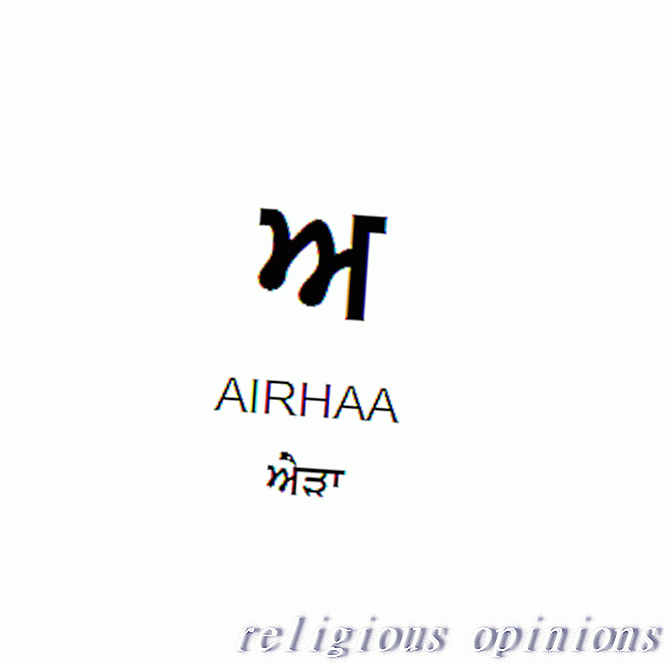 Pendżabski Akhar Airraa z Gurbani Znaczenie w pismach sikhijskich Airraa Gurmukhi Vowel Holder. Zdjęcie [S Khalsa]
Pendżabski Akhar Airraa z Gurbani Znaczenie w pismach sikhijskich Airraa Gurmukhi Vowel Holder. Zdjęcie [S Khalsa] Airraa jest drugim z trzech posiadaczy samogłosek pojawiających się w skrypcie Gurmukhi Gurbani i jest identyczna z posiadaczami samogłosek alfabetu pendżabskiego.
Airraa jest wymawiana z naciskiem na drugą sylabę i brzmi jak era lub err-raw. Airraa jest używana na początku słowa, w którym pierwszym dźwiękiem jest samogłoska lub w dowolnym słowie, w którym samogłoska nie jest poprzedzona spółgłoską, jak w przypadku dźwięku podwójnej samogłoski i ma przypisane specyficzne dźwięki samogłoski The Romanized pisownia Airraa jest fonetyczna i może również wydawać się pisana jako Airhaa . Pisownia może się nieznacznie różnić w oryginalnym Gurmukhi, a także w rzymskich i angielskich tłumaczeniach Gurbani.
Znaczenie Airraa w Piśmie Świętym Sikhów
Pismo sikhijskie obejmuje akrostyczną formę poetyckiego wersetu napisanego przez uczonego Guru Nanaka Deva jako młodego chłopca, gdy otrzymał zadanie domowe do pisania alfabetu. Jego nauczyciel wyraził zdziwienie, gdy dziecko Nanak Dev napisało:
„ Aa-i-rrai aap karae jin chhoddee jo kichh karnaa su kar rehi-aa ||
AIRRA: On sam stworzył świat, cokolwiek trzeba zrobić, On nadal działa. ”SGGS || 434
Przewodnik wymowy Gurmukhi Eerree
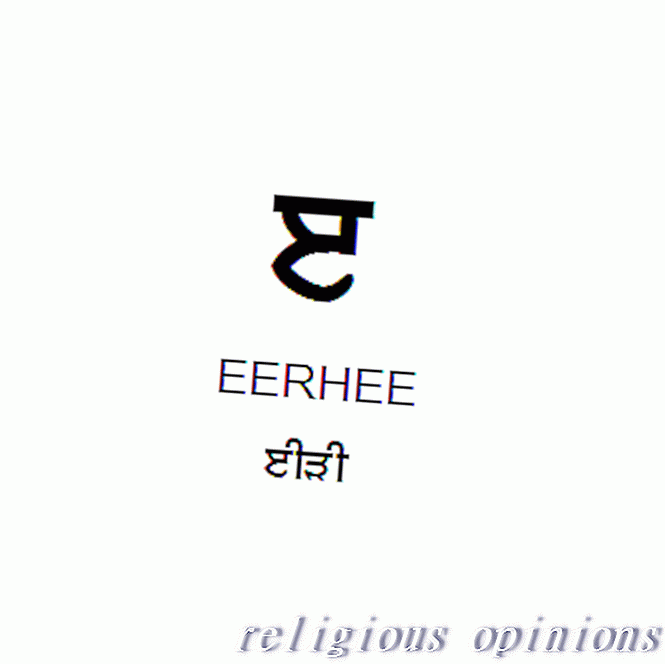 Pendżabski Akhar Eerree z Gurbani Znaczenie w pismach sikhijskich Eerree Gurmukhi Vowel Holder. Zdjęcie [S Khalsa]
Pendżabski Akhar Eerree z Gurbani Znaczenie w pismach sikhijskich Eerree Gurmukhi Vowel Holder. Zdjęcie [S Khalsa] Eerree jest trzecim z trzech posiadaczy samogłosek pojawiających się w skrypcie Gurmukhi Gurbani i jest identyczny z posiadaczami samogłosek alfabetu pendżabskiego.
Eerree jest wymawiane z naciskiem na drugą sylabę i brzmi jak era lub err-raw. Eerree jest używany na początku słowa, którego pierwszym dźwiękiem jest samogłoska lub w dowolnym słowie, w którym samogłoska nie jest poprzedzona spółgłoską, jak w przypadku dźwięku podwójnej samogłoski i ma przypisane specyficzne dźwięki samogłoski. pisownia Eerree jest fonetyczna i może również wydawać się pisana jako Eerhee lub Iri . Pisownia może się nieznacznie różnić w oryginalnym Gurmukhi, a także w rzymskich i angielskich tłumaczeniach Gurbani.
Znaczenie Eerree w Piśmie Świętym Sikhów
Pierwszy Guru Nanak zadziwił swojego nauczyciela swoim duchowym wglądem, kiedy otrzymał zadanie w szkole, aby napisać alfabet:
„ Eevrree aad purakh hai daataa aapae sachaa so-ee ||
EEVRREE: Pierwotny Pan jest obdarzającym, On tylko jest prawdziwy. ”SGGS || 432
04 z 36S - Gurmukhi Sassa Przewodnik wymowy
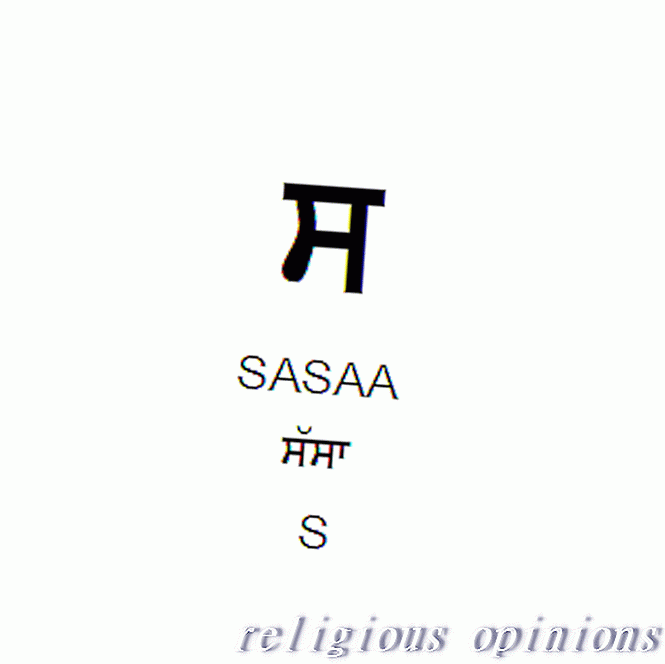 Pendżabski Akhar Sassa z Gurbani Znaczenie w pismach sikhijskich Gurmukhi Script Sassaa. Zdjęcie [S Khalsa]
Pendżabski Akhar Sassa z Gurbani Znaczenie w pismach sikhijskich Gurmukhi Script Sassaa. Zdjęcie [S Khalsa] Sassa jest jedną z 35 spółgłosek pisma Gurmukhi w języku Gurbani i jest identyczna z alfabetem pendżabskim. Spółgłoski Gurmukhi są znane jako 35 Akhar.
Sassa ma brzmienie S i jest wymawiane z naciskiem na drugą sylabę, taką jak sa-saw. Romanizowana pisownia Sassa jest fonetyczna i może również wydawać się pisana jako Sassaa . Pisownia może się nieznacznie różnić w oryginalnym Gurmukhi, a także w rzymskich i angielskich tłumaczeniach Gurbani.
Znaczenie Sassa w Piśmie Świętym Sikhów
Pismo sikhijskie zawiera kilka akrostych form poetyckiego wersetu napisanego przez autorów Guru Grantha Sahiba:
„ Sasai soe sristt jin saajee sabhnaa saahib aek bha-i-aa ||
SASSA: Ten, który stworzył świat, należy do całego Jedynego Mistrza. Pierwszy Guru Nanak Dev SGGS || 432
„ Sasai sabh jag sehaj oupaa-i-aa bhavan ik jotee ||
SASSA: Cały wszechświat stworzył z łatwością, oświetlając trzy królestwa jednym światłem. ”Pierwszy Guru Nanak SGGS || 930
Inne wersety akrostyczne z udziałem Sasa w Gurbani obejmują autorów:
Piąty guru Arjan Dev:
„ Sasaa saran parae ab haarae ||
SASSA: Wasz przybytek, do którego wszedłem, O Panie. ”SGGS || 260
„Sasaa siaanap chhaadd iaanaa ||
SASSA: Porzuć spryt, o głupiutki głupcze. "Guru Arjan Dev SGGS || 260
Bhagat Kabir:
„ Sasaa so neekaa kar sodhahu ||
SASSA: Dyscyplina umysłu z najwyższą doskonałością. ” Bhagat Kabir SGGS || 342
„ Sasaa so seh saej savaarai ||
SASSA: Łóżko oblubienicy duszy jest ozdobione obecnością jej Pana Męża. "Bhagat Kabir SGGS || 342
Trzeci Guru Amar Das:
„ Sasai sanjam ga-i-ou moorrae aek daan tudh kuthaa-e la-i-aa ||
SASSA: Straciłeś samodyscyplinę, głupcze, i przyjąłeś ofiary pod fałszywymi pozorami. ” SGGS || 345
H - Gurmukhi Haahaa Przewodnik wymowy
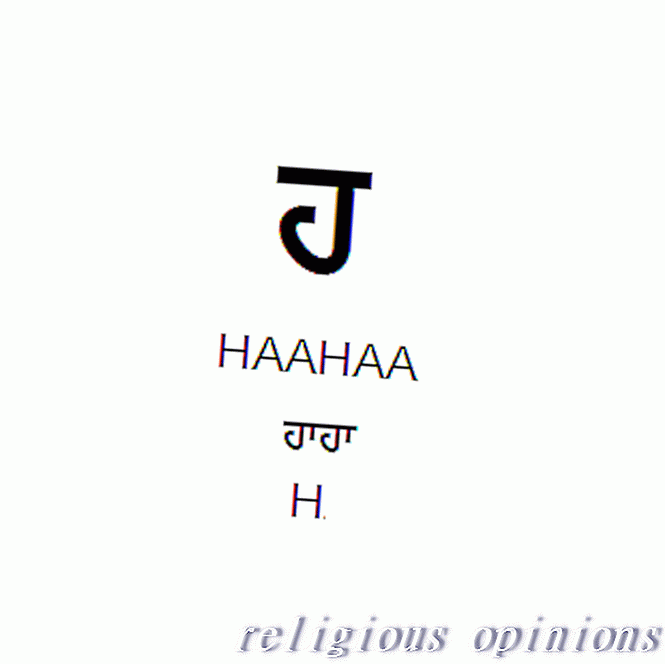 Pendżabski Akhar Haahaa Znaczenie w pismach sikhijskich Gurmukhi Script Haahaa. Zdjęcie [S Khalsa]
Pendżabski Akhar Haahaa Znaczenie w pismach sikhijskich Gurmukhi Script Haahaa. Zdjęcie [S Khalsa] Haahaa jest spółgłoską pisma Gurmukhi akhar Guru Grantha Sahiba i jest prawie identyczna z pendżabskim alfabetem malarskim.
Haahaa reprezentuje dźwięk H, podobnie jak w ha-ha, z równym naciskiem kładziony jest na obie sylaby i jest wymawiany tak, że podczas mówienia odczuwa się powiew powietrza, gdy dłoń jest trzymana przed ustami. Romanizowana pisownia Haahaa jest fonetyczna i może również wydawać się pisana jako Haha . Pisownia może się nieznacznie różnić w oryginalnym Gurmukhi oraz w romanizowanym i angielskim tłumaczeniu Gurbani.
Znaczenie w Piśmie Świętym Sikhów
Pismo sikhijskie zawiera poetyckie wersety z udziałem Haahaa napisane przez pierwszego mistrza guru Nanaka Deva jako ucznia, gdy został przydzielony do pisania alfabetu. Jego nauczyciel wyraził zdziwienie, gdy dziecko Nanak Dev napisało:
„ Haahai hor na koee daataa jeea oupaae jin rijak deeaa ||
HAHA: Nie ma innego Dawcy niż Ten, który stworzył stworzenia, daje im pokarm. ”SGGS || 435
Inne poetyckie kompozycje autorów Gurbani z udziałem Haahaa to:
„ Haahaa hot hoe nehee jaanaa ||
HAHA: Istnieje, ale nie wiadomo, że istnieje. ” Bhagat Kabir SGGS || 342
„ Haahai har kathaa boojh toon moorrae taa sadhaa sukh hoee ||
HAHA: Zrozum, boski dyskursie, głupcze, bo tylko wtedy osiągniesz wieczny pokój. ” Trzeci Guru Amar Das SGGS || 435
Alfabet Gurmukhi Kakaa z Gurbani ilustrowany wymową
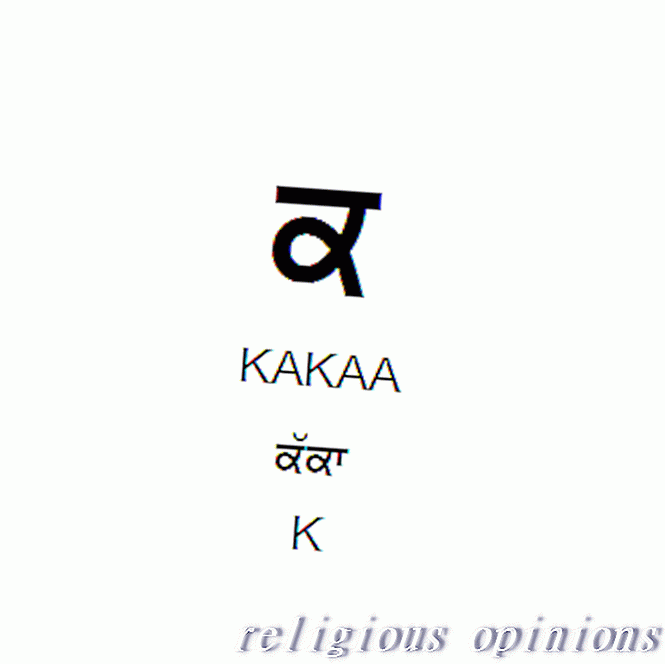 Pendżabski Akhar Kakaa z Gurbani Znaczenie w pismach sikhijskich Gurmukhi Script Kakaa. Zdjęcie [S Khalsa]
Pendżabski Akhar Kakaa z Gurbani Znaczenie w pismach sikhijskich Gurmukhi Script Kakaa. Zdjęcie [S Khalsa] Kakaa jest spółgłoską alfabetu Gurmukhi.
K - Gurmukhi Kakaa Przewodnik wymowy
Kakaa jest spółgłoską pisma Gurmukhi i jest prawie identyczny z alfabetem pendżabskim.
Kakaa jest wymawiane jako cka ckaaw (caw), z naciskiem na drugą sylabę. Gdy dłoń jest trzymana przed wargami, nie powinno być nadmuchu powietrza. Romanizowana pisownia Kakaa jest fonetyczna i może również wydawać się pisana jako Kakka . Pisownia może się nieznacznie różnić w oryginalnym Gurmukhi, a także w rzymskich i angielskich tłumaczeniach Gurbani.
Znaczenie Kakaa w Piśmie Świętym Sikhów
Pismo sikhijskie obejmuje akrostyczną formę poetyckiego wersetu w selekcjach w całym Guru Granth Sahib.
Pierwszy Guru Nanak Dev, zdziwił swoich instruktorów, gdy jako młody chłopiec otrzymał zadanie domowe w szkole, aby napisać alfabet, dziecko zareagowało duchowo:
„ Kakai kes punddar jab hoo-ae vin saaboonai oujaliaa ||
KAKKA: Kiedy włosy stają się białe, wtedy bez mycia lśnią. ”SGGS || 432
Inne wersety akrostyczne z udziałem Kakaa w Gurbani obejmują:
„ Kakaa kaaran karataa so-oo ||
KAKKA: On jest przyczyną, stworzeniem i Stwórcą. ”SGGS || 253 Piąty Guru Arjan Dev
„ Kakaa kiran kamal meh paavaa ||
KAKKA: Światło boskiej wiedzy oświetla lotos serca jego promieniem. ” SGGS || 340 Bhagat Kabir
„ Kakai kaam krodh bharami-o-hu moorrae mamtaa laagae tud har visar-i-aa ||
KAKKA: W pożądaniu i gniewie błąkasz się, głupcze zaangażowany w światową miłość, zapomniałeś Pana. ”SSGS || 435 Trzeci Guru Amar Das
Alfabet Gurmukhi Khakhaa z Gurbani ilustrowany wymową
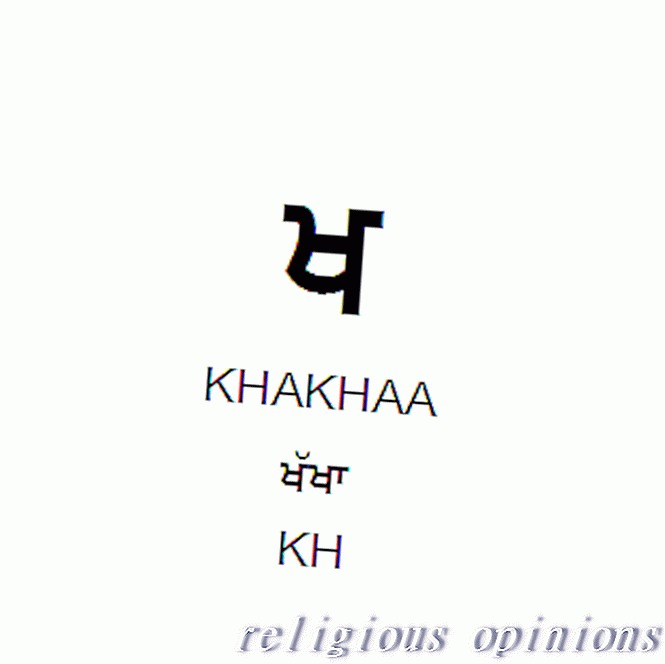 Pendżabski Akhar Khakhaa Znaczenie w pismach sikhijskich Gurmukhi Script Khakhaa. Zdjęcie [S Khalsa]
Pendżabski Akhar Khakhaa Znaczenie w pismach sikhijskich Gurmukhi Script Khakhaa. Zdjęcie [S Khalsa] Khakhaa jest spółgłoską alfabetu Gurmukhi.
KH - Gurmukhi Khakhaa Przewodnik wymowy
Khakhaa jest spółgłoską pisma Gurmukhi Gurbani i jest identyczna z alfabetem pendżabskim.
Khakhaa ma brzmienie Kh i jest wymawiane jako ka-kaaw (caw), z naciskiem na drugą sylabę. Gdy dłoń jest trzymana przed wargami, powinien być powiew powietrza. Romanizowana pisownia Khakhaa jest fonetyczna i może również wydawać się pisana jako Khakha . Pisownia może się nieznacznie różnić w oryginalnym Gurmukhi, a także w rzymskich i angielskich tłumaczeniach Gurbani.
Znaczenie Khakhaa w Piśmie Świętym Sikhów
Pismo sikhijskie obejmuje akrostyczną formę poetyckiego wersetu z udziałem Khakhaa z alfabetu Gurmukhi i pojawia się w różnych wersjach w całym Guru Granth Sahib.
Guru Nanak, pierwszy guru Sikhów, zaskoczył swoich instruktorów, gdy jako młody chłopiec, któremu powierzono zadanie domowe w szkole, aby napisać alfabet, dziecko odpowiedziało duchowym akrostykiem:
„ Khakhai khundhkaar saah aalam kar khareed jin kharach deeaa ||
KHAKHA: Światowy pan, twórca oddechu i czasu, czerpie dochód z braku utrzymania. "SGGS || 432
Inne wersety akrostyczne w Gurbani obejmują kilku autorów Guru Granth Sahib:
Kompozycje poetyckie na cześć Wszechmogącego Piątego Guru Arjun Dev
„ Khakhaa khoonaa kachh nehee tis sanmrath kai paa-eh ||
KHAKHA: Wszechmocny Pan niczego nie brakuje. ”SGGS || 253
„ Khakhaa kharaa saraahou taahoo ||
KHAKHA: Naprawdę chwalcie Go. "SGGS | 260
Poetycki wgląd w duszę Bhagat Kabir
„ Khakhaa i-ahai khorr man aavaa ||
KHAKHA: Dusza wchodzi do jaskini ciała. "SGGS || 340
„ khakhaa khoj parai jo koee ||
KHAKHA: Rzadcy szukający Go szukają. ”SGGS || 342
„ Khakhaa khirat khapat ga-e kaetae ||
KHAKHA: Wielu, którzy zmarnowali i zrujnowali swoje życie, ginie. "SGGS || 342
Gurmukhi Alfabet Gagaa z Gurbani ilustrowany wymową
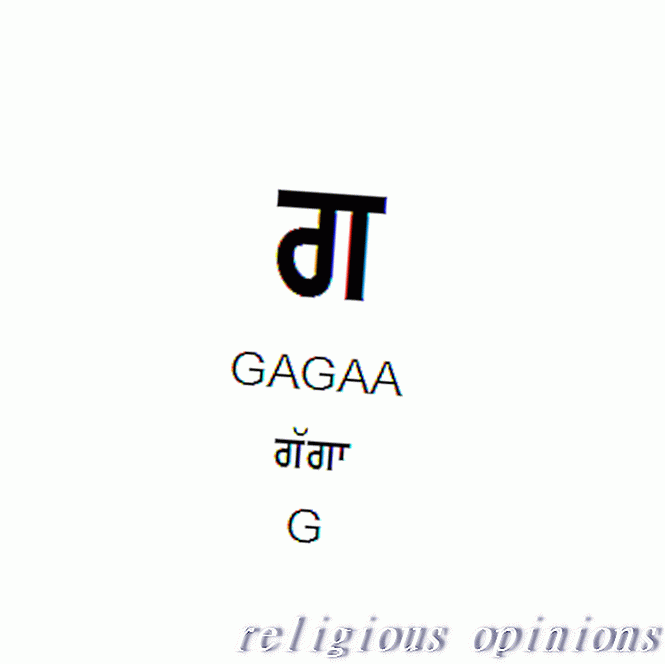 Pendżabski Akhar Gagaa Znaczenie w pismach sikhijskich Gurmukhi Script Gagaa. Zdjęcie [S Khalsa]
Pendżabski Akhar Gagaa Znaczenie w pismach sikhijskich Gurmukhi Script Gagaa. Zdjęcie [S Khalsa] Gagaa jest spółgłoską alfabetu Gurmukhi akhar.
G - Gurmukhi Gagaa Przewodnik wymowy
Gagaa jest spółgłoską pisma Gurmukhi akhar z Gurbani i jest identyczna z pendżabskim alfabetem malarskim.
Gagaa wymawia się jako ga-gaw, z naciskiem na drugą sylabę. Gdy dłoń jest trzymana przed wargami, nie powinno być nadmuchu powietrza. Romanizowana pisownia Gagaa jest fonetyczna i może również wydawać się pisana jako Gagga . Pisownia może się nieznacznie różnić w oryginalnym Gurmukhi, a także w rzymskich i angielskich tłumaczeniach Gurbani.
Znaczenie Gagaa w Piśmie Świętym Sikhów
Pismo sikhijskie zawiera akrostyczną formę poetyckiego wersetu i pojawia się w całym Guru Granth Sahib z istotnymi wglądami duchowymi, zawierającymi Gagaa alfabetu Gurmukhi .
Guru Nanak, pierwszy z guru Sikhów, zdziwił swoich instruktorów, gdy jako młody chłopiec, któremu powierzono zadanie domowe w szkole, aby napisać alfabet, dziecko odpowiedziało duchowym akrostykiem:
„ Gagai goe gaae jin chhoddee galee gobid garab bha-iiaa ||
GAGGA: Kto rezygnuje ze śpiewania piosenek Uniwersalnego Pana, staje się arogancki w mowie. ”SGGS || 432
Inne wersety akrostyczne w Gurbani obejmują:
Piąty guru Arjun Dev chwali efekty medytacji:
„ Gagaa gobid gun ravhou saas saas jap neet ||
GAGGA: Wypowiadaj chwalebne chwale Mistrza Świata z każdym oddechem medytującym o Nim zawsze. ”SGGS || 254
Werset Bhagat Kabir wyjaśnia oświecającego guru:
„ Gagaa gur kae bachan pachhaanaa ||
GAGGA: Zrozumienie instrukcji Oświecenia. ”SGGS || 340
Trzeci Guru Amar Das rozważa ogrom wszechświata.
„ Gagai gobid chit kar moorrae galee kinai na paa-i-aa ||
Gagga: Zastanów się nad uniwersalnym lordem, głupcze, zwykłą mową nikt nigdy go nie osiągnął. ”SGGS || 434
Alfabet Gurmukhi Ghaghaa z Gurbani ilustrowany wymową
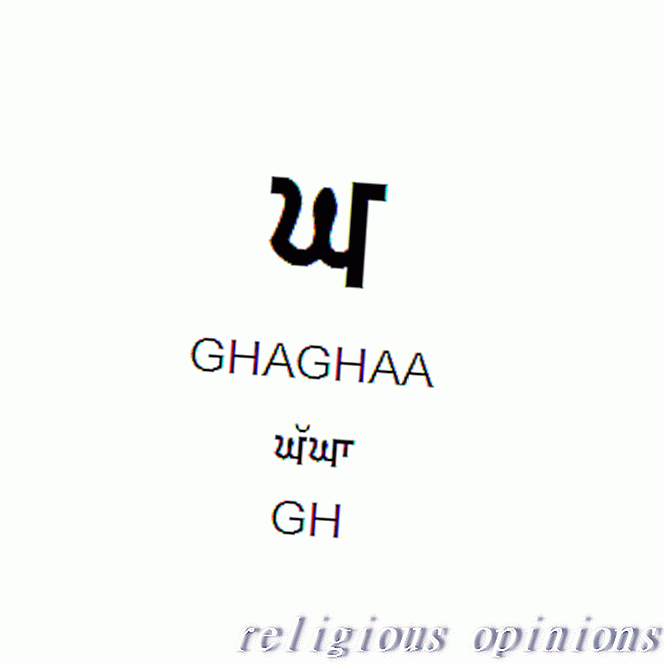 Pendżabski Akhar Ghaghaa Znaczenie w pismach sikhijskich Gurmukhi Script Ghaaghaa. Zdjęcie [S Khalsa]
Pendżabski Akhar Ghaghaa Znaczenie w pismach sikhijskich Gurmukhi Script Ghaaghaa. Zdjęcie [S Khalsa] Ghaghaa jest spółgłoską alfabetu Gurmukhi.
GH - Gurmukhi Ghaghaa Przewodnik wymowy
Ghaghaa jest spółgłoską skryptu Gurmukhi akhar, który jest bardzo podobny do pendżabskiego alfabetu malarskiego.
Ghaghaa jest wymawiane jako gha ghaaw, z naciskiem na drugą sylabę. Gdy dłoń jest trzymana przed wargami, powinien być powiew powietrza. Romanizowana pisownia Ghaghaa jest fonetyczna i może również wydawać się pisana jako Ghagha . Pisownia może się nieznacznie różnić w oryginalnym Gurmukhi, a także w rzymskich i angielskich tłumaczeniach Gurbani.
Znaczenie Ghaghaa w Piśmie Świętym Sikhów
Pismo sikhijskie zawiera wersety z udziałem Ghaghaa z alfabetu Gurmukhi różnych autorów Gurbani i pojawia się w całym Guru Granth Sahib.
Guru Nanak, pierwszy guru Sikhów, zdziwił swoich instruktorów, kiedy otrzymał zadanie w szkole, aby napisać alfabet, dziecko odpowiedziało duchowym akrostykiem:
„ Ghaghai ghaal saevak jae ghaalai sabad guroo kai laag rehai ||
Pełniąc służbę opiekunowi, nawet gdy służy się boskim hymnom dołączonego Oświecenia, pozostaje. ”SGGS || 432
Inne znaczące wersety poetyckie autorów Guru Granth Sahib z udziałem Ghaghaa obejmują:
Piąty guru Arjan Dev podkreśla, że istnieje tylko Bóg.
„ Ghaghaa ghaalhou maneh eh bin har doosar naa-he ||
GHAGHA: Zapamiętaj to, że nie ma innego niż Pan. ”SGGS || 254
Bhagat Kabir mówi, gdzie znajduje się boskość.
„ Ghaghaa ghatt ghatt nimasai soee ||
GHAGHA: W każdym sercu przebywa. ”SGGS || 340
Trzeci Guru Amar Das daje wgląd, że jakkolwiek dusza szuka, nie rozpoznaje prawdziwych darów i błogosławieństw.
„ Ghaghai ghar ghar fireh Toon moorrae dadai daan na tudh la-i-aa || 9 ||
GHAGHA: Od drzwi do drzwi, błagasz, głupcze. Dadda: Ale błogosławieństwa, których nie akceptujesz. ”SGGS || 423
Alfabet Gurmukhi Ngangaa z Gurbani ilustrowany wymową
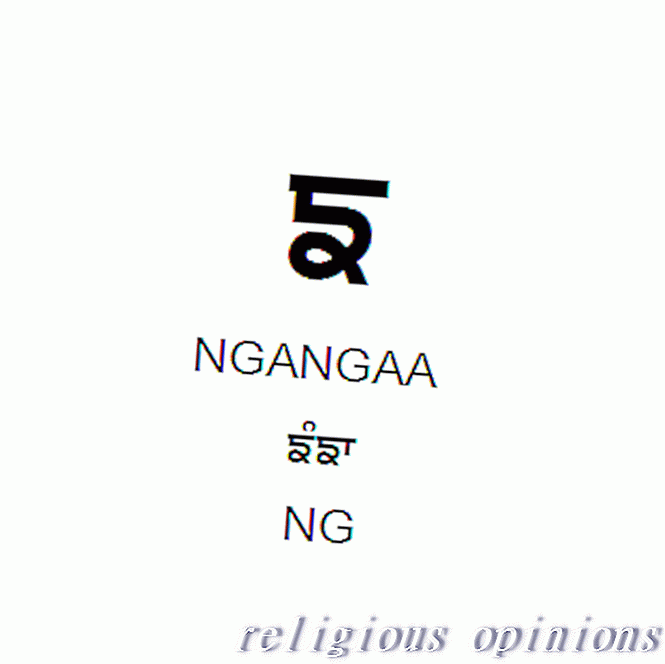 Pendżabski Akhar Ngangaa Znaczenie w pismach sikhijskich Gurmukhi Script Ngangaa. Zdjęcie [S Khalsa]
Pendżabski Akhar Ngangaa Znaczenie w pismach sikhijskich Gurmukhi Script Ngangaa. Zdjęcie [S Khalsa] Ngangaa jest spółgłoską alfabetu Gurmukhi.
NG - Przewodnik po wymowie Gurmukhi Ngangaa
Ngangaa jest spółgłoską pisma Gurmukhi Akhar pisma Gurbani i jest identyczna z pendżabskim alfabetem malarskim.
Ngangaa ma brzmienie NG i jest wymawiane z naciskiem na drugą sylabę. Romanizowana pisownia Ngangaa jest fonetyczna i może również wydawać się pisana jako Nganga lub Nganngaa . Pisownia może się nieznacznie różnić w oryginalnym Gurmukhi, a także w rzymskich i angielskich tłumaczeniach Gurbani.
Znaczenie Ngangaa w Piśmie Świętym Sikhów
Pismo sikhijskie w całym Guru Granth Sahib zawiera alfabetyczne kompozycje akrostyczne w formie poetyckiego wersetu zawierającego wgląd o znaczeniu duchowym.
Guru Nanak Dev jako chłopiec zaskoczył swojego nauczyciela, gdy otrzymał polecenie pisania alfabetu, a on odpowiedział akrosto na temat uczonego duchowego:
„ Ngan-ngai ngiaan boojhai jae koee parriaa panddit soee ||
NGANGA: Osoba ze zrozumieniem wiedzy duchowej zostaje uczonym religijnym. ”SGGS || 432
Inne znaczące wersety akrostyczne z udziałem Ngangaa przez autorów Gurbani bani to:
Piąty guru Arjund Dev wyjaśnia w tych liniach uczonych o duchowej mądrości i pułapkach materialnego świata.
„ Ngan-ngaa ngiaan nehee mukh baato ||
NGANGA: Boskiej mądrości nie uzyskuje się jedynie ustnie. "Guru Arjun SGGS || 251
„ Ngan-ngaa khatt saastra hoe ngiaataa ||
NGANGA: Można być uczonym sześciu szkół filozofii. "Guru Arjun SGGS || 253
„ Ngan-ngaa ngraasai kaal teh jo saakat prabh keen ||
NGANGA: Śmierć chwyta tego, który został wyświęcony przez Boga, aby był czcicielem świata materialnego. ”SGGS || 2534
Bhagat Kabir doradza w swoim wersecie niewątpliwą mądrość:
„ Ngan-ngaa nigreh anaehu kar nirvaaro sandaeh ||
NGANGA: Stosujcie powściągliwość, kochajcie boskość i rozwiewajcie wątpliwości. ”SGGS || 340
Alfabet Gurmukhi Chachaa Gurbani ilustrowany wymową
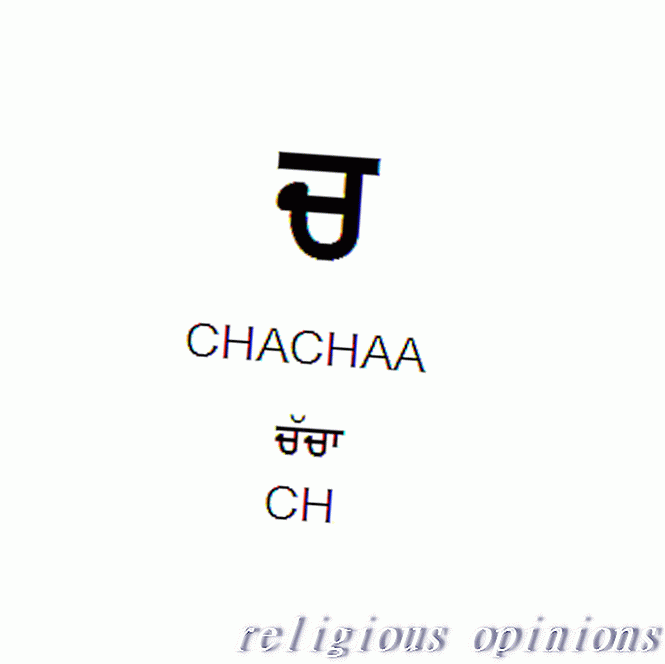 Pendżabski Akhar Chachaa Znaczenie w pismach sikhijskich Gurmukhi Script Chachaa. Zdjęcie [S Khalsa]
Pendżabski Akhar Chachaa Znaczenie w pismach sikhijskich Gurmukhi Script Chachaa. Zdjęcie [S Khalsa] Chachaa jest spółgłoską alfabetu Gurmukhi.
Ch - Gurmukhi Chachaa Przewodnik wymowy
Chachaa jest spółgłoską pisma `` Gurmukhi akhar '' Gurbani, która jest identyczna z pendżabskim alfabetem malarskim.
Chachaa jest symbolem CH i wymawia się ją językiem tuż za górnymi zębami jak ch w swędzeniu, z naciskiem na drugą sylabę. Chachaa jest fonetyczny i może również wyglądać na orkisz jako Chacha . Pisownia Phonetci może nieznacznie różnić się oryginalną gramatyką Gurmukhi, a także romanizowanym i angielskim tłumaczeniem Gurbani.
Znaczenie Chachaa w Piśmie Świętym Sikhów
W całym piśmie Guru Granth Sahib akrostyczna forma poetyckiego wersetu wyjaśnia duchowe znaczenie alfabetu Gurmukhi.
Pierwszy Guru Nanak Dev zadziwił swoich wychowawców, gdy jako młody chłopiec, któremu powierzono zadanie napisania alfabetu, dziecko odpowiedziało duchowym akrostykiem na temat tekstów wedyjskich:
„ Chachai chaar ved jin saajae chaarae khaanee chaar jugaa ||
CHACHA: Jest twórczym źródłem czterech pism wedyjskich, czterech metod prokreacji i czterech wieków. ”SGGS || 432
„ Bas jal nit na vasat alee-al maer * cha-chaa * gun rae ||
(O głupia żabo) mieszkasz zawsze w wodzie (gdzie kwitnie lilia), ale trzmiele, które tam nie mieszkają * głód - odurza * zapachem (lilii) z daleka. ”SGGS || 990
Inne znaczące wersety alfabetyczne z Chachą różnych autorów Guru Granth Sahib obejmują:
Piąty Guru Arjun Dev w swoim wersecie opisującym jego związek z boskością.
„ Chachaa charan kamal gur laagaa ||
CHACHA: Do lotosowych stóp Oświeciciela jestem przywiązany. "SGGS || 254
Bhagat Kabir, którego poezja opisuje boski kunszt.
„ Chachaa rachit chitra hai bhaaree ||
CHACHA: Namalował wielki portret, którym jest świat. ”SGGS || 340
Alfabet Gurmukhi Chhachhaa z Gurbani ilustrowany wymową
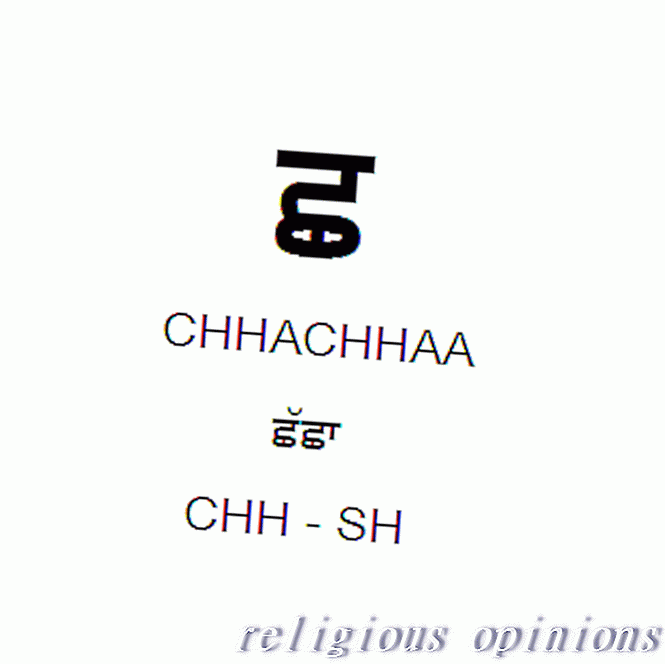 Pendżabski Akhar Chhachhaa Znaczenie w Sikh Pisma Gurmukhi Pismo Chhachhaa. Zdjęcie [S Khalsa]
Pendżabski Akhar Chhachhaa Znaczenie w Sikh Pisma Gurmukhi Pismo Chhachhaa. Zdjęcie [S Khalsa] Chhachhaa jest spółgłoską alfabetu Gurmukhi.
CHH (SH) - Gurmukhi Chhachhaa Przewodnik wymowy
Chhachhaa jest spółgłoską alfabetu Gurmukhi akhar z Gurbani i identyczną z alfabetem pendżabskim.
Chhachhaa ma dźwięk C w oceanie i jest wymawiany z naciskiem na drugą sylabę. Romanizowana pisownia Chhachhaa jest fonetyczna i może również wydawać się pisana jako Chhachha lub Shhassha i Shhasshaa . Pisownia może się nieznacznie różnić w oryginalnym Gurmukhi, a także w rzymskich i angielskich tłumaczeniach Gurbani.
Znaczenie Chhachhaa w Piśmie Świętym Sikhów
W całym wersecie Guru Granth Sahib można znaleźć poetyckie wersety przedstawiające duchowe znaczenie alfabetu Gurmukhi akhar Chhachhaa :
Guru Nanak, pierwszy z guru Sikhów, zadziwił swoich instruktorów alfabetycznym akrostykiem spiirtualnej ignorancji:
„ Chhachhai chhaa-i-aa vartee sabh antar tera keeaa bharam hoaa ||
CHHACHHA: Rozpowszechnianie duchowej ignorancji dotyczy wszystkich, którzy wątpią w twoje czyny. ”SGGS || 433
Inne alfabetyczne akrostyki w Gurbani obejmują wersety różnych autorów Guru Granth Sahib:
Piąty guru Arjun Dev opowiada o swojej doskonałej pokorze w swoich wersetach:
„ Chhashhaa Chhoharae daas tumaarae ||
CHHACHHA: To dziecko jest twoim sługą. ”SGGS || 254
„ Chhachhaa chhaar hot tere santaa ||
CHHACHHA: Obym stał się prochem pod twoimi Świętymi. ”SGGS || 254
Bhagat Kabir rozważa obecność Boga w swoim wersecie:
„ Chhashhaa ihai chhatrapat paasaa ||
CHHACHHA: Czcigodny Lord Mistrz jest obecny. "SGGS || 340
„ Chhachhai chheejeh ahnis moorrae kio chhootteh jam paakarri-aa || 2 ||
Trzeci guru Amar Das kwestionuje wartość słownych zajęć w swoim wersecie:
CHHACHHA: Zużywasz się na noc i dzień, głupcze, jak możesz znaleźć uwolnienie trzymane szybko w szponach śmierci? "|| 2 || SGGS || 434
13 z 36Gurmukhi Alfabet Jajaa z Gurbani ilustrowany wymową
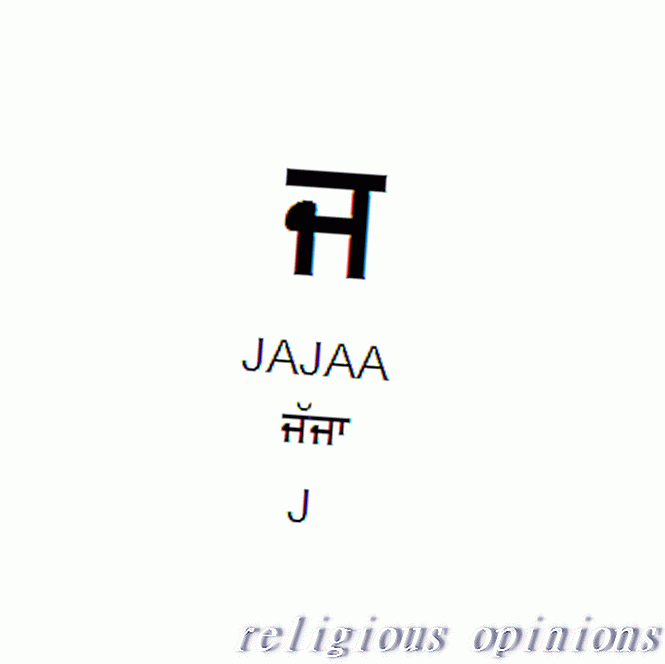 Pendżabski Akhar Jajaa Znaczenie w pismach sikhijskich Gurmukhi Script Jajaa. Zdjęcie [S Khalsa]
Pendżabski Akhar Jajaa Znaczenie w pismach sikhijskich Gurmukhi Script Jajaa. Zdjęcie [S Khalsa] Jajaa jest spółgłoską alfabetu Gurmukhi.
J - Gurmukhi Jajaa Przewodnik wymowy
Jajaa jest spółgłoską 35-znakowego pisma Gurmukhi akhar Gurbani, który jest identyczny z pendżabskim alfabetem malowanym.
Jajaa ma brzmienie J i jest wymawiane z naciskiem na drugą sylabę jak ja-jaw. Romanizowana pisownia Jajai jest fonetyczna i może również wydawać się pisana jako Jajja . Pisownia może się nieznacznie różnić w oryginalnym Gurmukhi, a także w romańskich i angielskich tłumaczeniach Gurbani na fonety.
Znaczenie Jajaa w Piśmie Świętym Sikhów
Guru Granth Sahib z pisma sikhijskiego zawiera akrostyczną formę poetyckiego wersetu, napisanego przez pierwszego Pierwszego Guru Nanaka Deva jako młodego ucznia, który otrzymał polecenie pisania alfabetu:
„ Jajai jaan mangat jan jaachai lakh chouraaseeh bheekh bhaviaa ||
JAJJA: Ta skromna istota błaga o mądrość, błąkając się żebrząc przez osiemdziesiąt cztery lakhs (8, 4 miliona) egzystencji. "SGGS || 433
Inne akrostyczne wersety w Gurbani obejmują wersety o znaczeniu duchowym przedstawiające Jajaę przez kilku innych autorów Guru Granth Sahib, w tym:
„ Jajaa jaanai ho kashh hooaa ||
JAJJA: Ześrodkowany na Ego wierzy, że stał się czymś. ”SGGS || 255 autor: Piąty Guru Arjan Dev
„ Jajaa jo tan jeevat jaraavai ||
JAJJA: Ktokolwiek pali ciało jeszcze za życia. "SGGS || 340 autorstwa Bhagat Kabir
„ Jajai joh hir la-ee teree moorrae ant gaiaa pachhutaavehgaa ||
JAJJA: Zostałeś okradziony ze swojego boskiego światła, głupcze, żałując na końcu, odejdziesz z żalem. "SGGS || 434 przez Trzeci Guru Amar Das
14 z 36Alfabet Gurmukhi Jhajhaa z Gurbani ilustrowany wymową
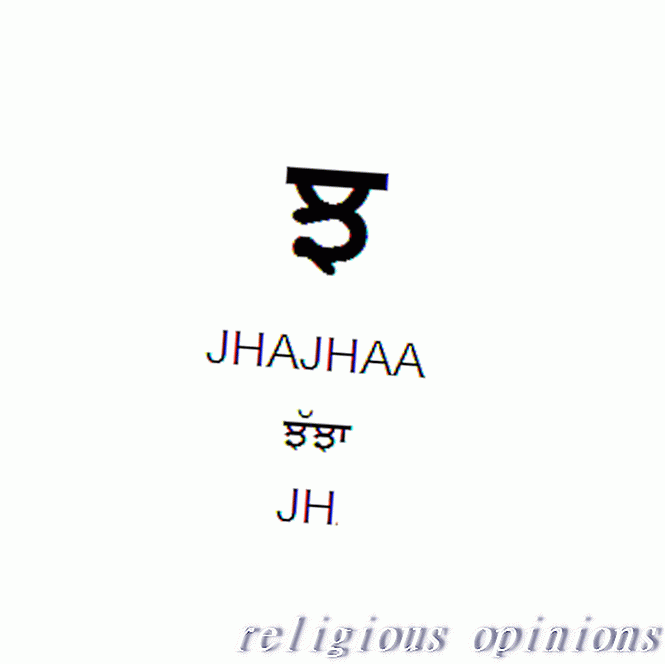 Pendżabski Akhar Jhajhaa Znaczenie w pismach sikhijskich Gurmukhi Script Jhajhaa. Zdjęcie [S Khalsa]
Pendżabski Akhar Jhajhaa Znaczenie w pismach sikhijskich Gurmukhi Script Jhajhaa. Zdjęcie [S Khalsa] Jhajhaa jest spółgłoską alfabetu Gurmukhi.
Jh - Gurmukhi Jhajhaa Przewodnik wymowy
Jhajhaa jest spółgłoską pisma Gurmukhi i jest identyczny z alfabetem pendżabskim.
Jhajhaa ma brzmienie Jh podobne do J jak w Jacques, Zs jak w Zsa Zsa lub X jak w Xenia i jest wymawiane jako Jh-jhaaw lub Zsa-Zsaa, z naciskiem na drugą sylabę. Gdy dłoń jest trzymana przed wargami, powinien być powiew powietrza. Romanizowana pisownia Jhajhaa jest fonetyczna i może również wydawać się pisana jako Jhajha . Pisownia może się nieznacznie różnić w oryginalnym Gurmukhi, a także w rzymskich i angielskich tłumaczeniach Gurbani.
Znaczenie pisma Jhajhaain Sikh
Pismo sikhijskie obejmuje akrostyczną formę poetyckiego wersetu z udziałem Jhajhaa z alfabetu Gurmukhi i pojawia się w całym Guru Granth Sahib .
Jako młody student Guru Nanak Dev ji napisał zorientowany duchowo werset potwierdzający wspaniałą naturę Boskości:
„ Jhajhai jhoor marhu kiaa praanee jo kichh daennaa so dae rehiaa ||
JHAJHA: O, śmiertelniku, dlaczego umierasz z niepokoju? Cokolwiek Pan daje, nieustannie udziela. ”SGGS || 433
Wersety akrostyczne w Gurbani autorstwa innych autorów Guru Granth Sahib obejmują:
„ Jhajhaa jhooran mittai tumaaro ||
JHAJHA: Twoje smutki się skończą. ” SGGS || 255 Guru Arjan Dev
„ Jhajhaa ourajh surajh nehee jaanaa ||
JHAJHA: Jesteś uwikłany w świat i nie wiesz, jak się rozplątać. ” SGGS || 340 Bhagat Kabir
„ Jhajhai kadhae no jhooreh moorrae satgur kaa oupadaes sun toon vikhaa ||
JHAJHA: Może nigdy nie będziesz potrzebować pokuty, głupcze, gdybyś choć przez chwilę słuchał instrukcji Prawdziwego Oświecenia. ” SGGS || 435 Guru Amar Das
Alfabet Gurmukhi Njanjaa z Gurbani ilustrowany wymową
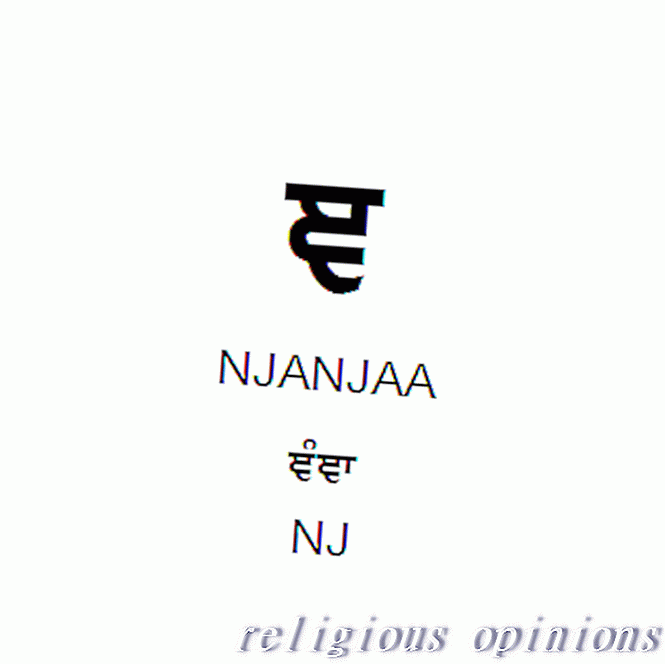 Pendżabski Akhar Njanjaa Znaczenie w pismach sikhijskich Gurmukhi Script Njanjaa. Zdjęcie [S Khalsa]
Pendżabski Akhar Njanjaa Znaczenie w pismach sikhijskich Gurmukhi Script Njanjaa. Zdjęcie [S Khalsa] Njanjaa jest spółgłoską alfabetu Gurmukhi.
Nj - Gurmukhi Njanjaa Przewodnik wymowy
Njanjaa jest spółgłoską skryptu Gurmukhi, która jest identyczna z alfabetem pendżabskim.
Mówi się, że język Njanjaa jest przyciśnięty do górnej części jamy ustnej za górnymi zębami, z naciskiem na drugą sylabę. Njanjaa jest fonetyczna, Nj może być również napisane jako Ny lub nawet Ni i jest wymawiane jak Enya, cebula lub Kalifornia, a nie przyjemność lub silnik. Njanjaa może również wyglądać na orkisz jako Nyanya, ponieważ pisownia różni się nieznacznie w oryginalnych tekstach Gurmukhi, a także w rzymskich i angielskich tłumaczeniach Gurbani.
Znaczenie Njanjaa w Piśmie Świętym Sikhów
Pismo sikhijskie obejmuje akrostyczne formy poetyckiego wersetu z udziałem Njanjaa .
Wykazując duchowy wgląd, gdy był jeszcze chłopcem, Guru Nanak Dev pierwszy z guru Sikhów napisał:
„ Njannjai nadar karae jaa daekhaa doojaa koee naahee ||
Obdarzona wizją jego wdzięcznego spojrzenia, nie widzę nikogo poza nim. ”SGGS || 433
Inne znaczące akrostyczne shabady Gurbani z Njanjaą obejmują:
„ Njannjaa njaanhu drirr sehee binas jaat eh hae-et ||
NYANYA: Wiedz jak całkowicie słuszne, że światowa miłość skończy się. ”Piąty Guru Arjun Dev SGGS || 255
„ Njannjaa nikatt ju ghatt rehio door kehaa taj jaa-e ||
NYANYA: Mieszka niedaleko w twoim sercu, po co szukać Go daleko? ”SGGS || 340 Bhagat Kabir
Gurmukhi Script Tainkaa z Gurbani ilustrowany wymową
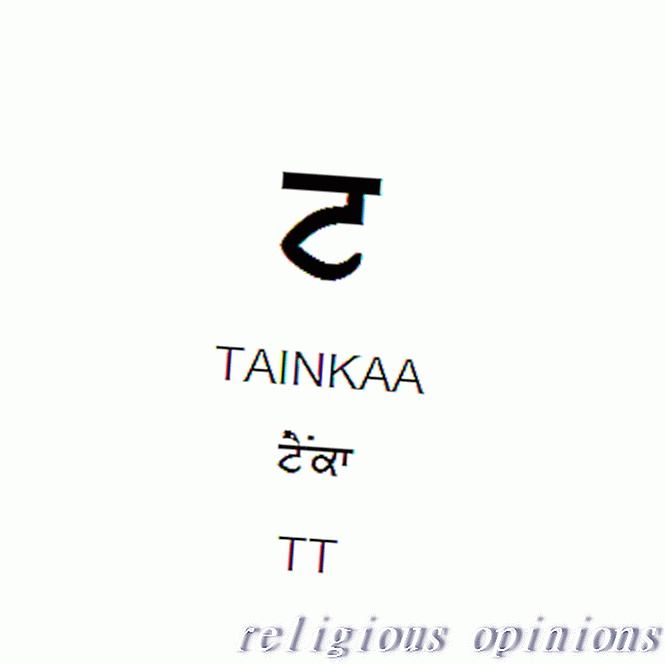 Pendżabski Akhar Tainkaa z Gurbani Illustrated Gurmukhi Script Tainkaa. Zdjęcie [S Khalsa]
Pendżabski Akhar Tainkaa z Gurbani Illustrated Gurmukhi Script Tainkaa. Zdjęcie [S Khalsa] Tainkaa jest spółgłoską alfabetu Gurmukhi.
TT - Przewodnik wymowy Gurmukhi Tainka
Tainkaa jest spółgłoską pisma Gurmukhi, która jest identyczna z alfabetem pendżabskim.
Tainkaa brzmi jak tank-aw, reprezentuje twardy T jak w holowaniu, może być reprezentowany przez podwójne TT i wymawiany z językiem zwiniętym do tyłu, aby dotknąć dachu jamy ustnej. Romanizowana pisownia Tainkaa jest fonetyczna i może również wydawać się pisana jako Tanka, Tatta lub Ttatta, ponieważ pisownia może nieznacznie różnić się oryginalnymi tekstami Gurmukhi, a także romanizowanymi i angielskimi tłumaczeniami Gurbani.
Znaczenie Tainki w Piśmie Świętym Sikhów
Pismo sikhijskie zawiera wgląd duchowy napisany w formie wierszy akrostycznych przez pierwszego Guru Nanaka jako ucznia:
Ttattai ttanch karuh kiaa praannee gharree ke mueht ke ootth chalnaa ||
TATTA: Dlaczego ćwiczysz hipokryzję, śmiertelniku? Za chwilę wstaniesz i natychmiast odejdziesz. ”SGGS || 433
Inne święte akrostyczne wersety z Tattą obejmują Bhagat Kabir:
„ Ttattaa bikatt ghaatt ghatt maahee ||
TATTA: Trudna droga do Boga prowadzi ścieżką serca i umysłu wewnątrz. ”SGGS || 341
Skrypt Gurmukhi Tthatthhaa z Gurbani ilustrowany wymową
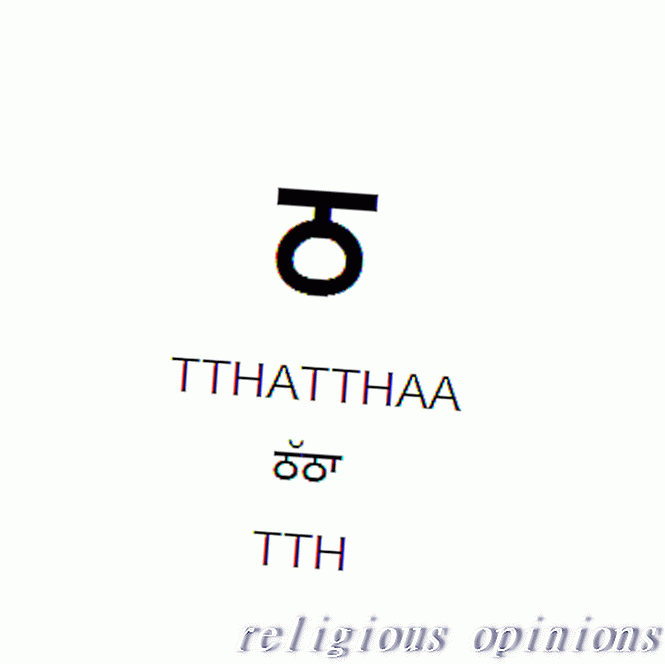 Pendżabski Akhar Tthatthhaa Znaczenie w pismach sikhijskich Gurmukhi Pismo TThatthaa. Zdjęcie [S Khalsa]
Pendżabski Akhar Tthatthhaa Znaczenie w pismach sikhijskich Gurmukhi Pismo TThatthaa. Zdjęcie [S Khalsa] Tthatthhaa jest spółgłoską alfabetu Gurmukhi.
TTH - Gurmukhi Tthatthaa Przewodnik wymowy
Tthatthaa jest spółgłoską akhar Gurmukhi, która jest identyczna z alfabetem pendżabskim.
Tthatthaa ma brzmienie Th i jest wymawiane jako tha-thaaw z naciskiem na drugą sylabę. Język jest zwinięty do tyłu, aby dotykał górnej części jamy ustnej, a gdy dłoń jest trzymana przed wargami, powinien być powiew powietrza. Romanizowana pisownia Tthatthaa jest fonetyczna i może również wydawać się pisana jako Tthattha, Thhathaa lub inne odmiany. Oryginalne fonetyczne pisownie Gurmukhi mogą różnić się wzrokowo, podobnie jak romanizowane i angielskie tłumaczenia Gurbani.
Znaczenie Tththaa w Piśmie Świętym Sikhów
Akrostyczne formy duchowo znaczącego poetyckiego wiersza zawierające spółgłoski alfabetu Gurmukhi pojawiają się w całym piśmie Guru Granth Sahib. Jako chłopiec z Nanakana Sahib reformator Guru Nanak Dev napisał:
Tthhatthhai thhaadhh vartee cyna antar har charnee jinh kaa chit laagaa ||
TTHHATTHA: Pokój przenika serce tych, których umysł jest przywiązany do Lotosowych Stóp Pana. ”SGGS || 433
Inne akrostyczne wersety z udziałem Tthatthaa autorstwa Gurbani obejmują:
„ Tthhatthaa manooaa thhaaheh naahee ||
TTHHATTHA: Nie odczuwa się krzywdy. ”SGGS || 256 Piąty Guru Arjun Dev
„ Tthhatthhaa ehai door thhag neeraa ||
TTHHATTHA: Trzymaj się z daleka od tego mirażu. ”SGGS 341 Bhagat Kabir
Alfabet Gurmukhi Ddaddaa z Gurbani ilustrowany wymową
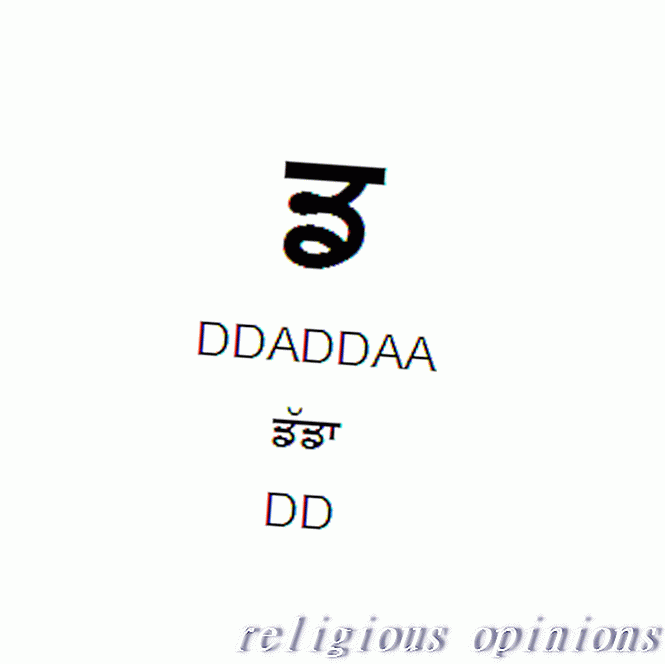 Pendżabski Akhar Ddaddaa Znaczenie w pismach sikhijskich Gurmukhi Script Ddaddaa. Zdjęcie [S Khalsa]
Pendżabski Akhar Ddaddaa Znaczenie w pismach sikhijskich Gurmukhi Script Ddaddaa. Zdjęcie [S Khalsa] Ddaddaa jest spółgłoską alfabetu Gurmukhi.
DD - Gurmukhi Ddaddaa Przewodnik wymowy
Ddaddaa jest spółgłoską funkcji pisma Gurmukhi w Gurbani i jest identyczny z alfabetem pendżabskim.
Ddaddaa jest reprezentowana przez DD i jest wymawiane jako Da-daaw, z naciskiem na drugą sylabę. Język jest zwinięty do tyłu, aby dotknąć górnej części ust za grzbietem dziąseł. Dźwięk jest podobny do podwójnego DD u tatusia lub D u ropuchy lub lekarza. Romanizowana pisownia Ddaddaa jest fonetyczna i może również wydawać się pisana po prostu jako Dadda . Pisownia może się nieznacznie różnić w oryginalnym Gurmukhi, a także w rzymskich i angielskich tłumaczeniach Gurbani.
Znaczenie Ddaddaa w Piśmie Świętym Sikhów
Kilka szabadów Guru Granth Sahib przedstawia Ddaddaa w akrostycznej formie poetyckiego wiersza o duchowym znaczeniu.
Guru Nanak, pierwszy z guru Sikhów, zaczął pisać hymny o duchowych zasługach, gdy był jeszcze chłopcem:
„ Ddaddai ddanph karhu kiaa praannee jo kichh hoaa su sabh chalnaa ||
DDADDA: Dlaczego wystawiasz takie ostentacyjne programy, o śmiertelniku? Cokolwiek istnieje, wszystko przeminie. ”SGGS || 433
Inne akrostyczne wersety autorów Gurbani, w których docenia Ddaddaa, obejmują:
„ Ddaddaa ddaeraa ehu nehee jeh dderaa teh jaan ||
DDADDA: To miejsce nie jest twoim prawdziwym miejscem zamieszkania, o którym musisz wiedzieć. ”SGGS || 256 Piąty Guru Arjan Dev
„ Ddaddaa ddar oupajae ddar jaaee ||
DDADDA: Kiedy strach przed Bogiem się urzeczywistni, inne lęki odchodzą. ”SGGS || 341 Bhagat Kabir
Alfabet Gurmukhi Dhhadhhaa z Gurbani ilustrowany wymową
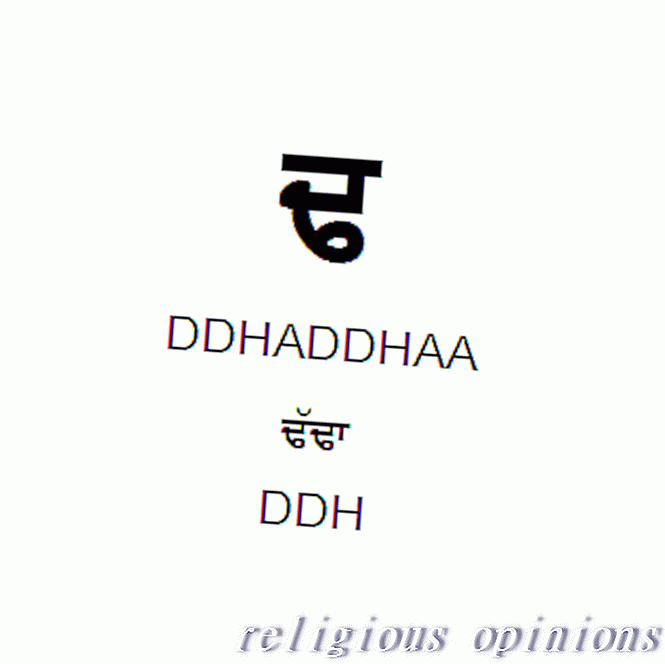 Punjabi Akhar Dhhhaddhhaa Significance in Sikh Scripture Gurmukhi Script DDhaddhaa. Zdjęcie [S Khalsa]
Punjabi Akhar Dhhhaddhhaa Significance in Sikh Scripture Gurmukhi Script DDhaddhaa. Zdjęcie [S Khalsa] Ddhaddhaa is a consonant of the Gurmukhi alphabet.
Dhh - Gurmukhi Dhhadhhaa Pronunciation Guide
Dhhadhhaa is a consonant of the Gurmukhi script featured in the hymns of Gurbani, and is identical to the Punjabi alphabet.
Dhhadhhaa has the sound of Dh and is pronounced as dha-dhaaw, with emphasis on the second syllable. The tongue is curled back to touch the roof of the mouth behind the gum ridge. There should be a puff of air when when the hand is held in front of the lips. The Romanized spelling of Dhhadhhaa is phonetic and may also appear spelled as Ddhaddhaa or even variations of Dtadtaa . Spellings also may differ slightly in original Gurmukhi as well as Romanized and English translations of Gurbani.
Significance of Dhhadhhaa in Sikh Scripture
The acrostic form of poetry featuring Dhhadhhaa of the Gurmukhi alphabet appears in several of the Guru Granth Sahib hymns.
While still a child, First Guru Nanak stressed the spiritual signifigance of poetic composition when he wrote:
" Dhhadhhai dhhaa-eh ousaarai aapae jio tis bhaavai tivai karae ||
DHHADHHA: The Lord himself establishes and disestablishes, as it pleases Him so does He do." SGGS||432
Other such acrostic verses in Guru Granth Sahib include:
" Dhhadhhaa dhhoodhhat keh phirhu dhhoodhhan e-aa man maa-eh || ||
DHHADHHA: Where do you wander about to go searching? Search instead within your own mind." Fifth Guru Arjan Dev SGGS||256
" Dhhadhhaa dhhig dhhoodhheh kat aanaa ||
DHHADHHA: Why do you search for him elsewhere in every other direction? SGGS||341 Bhagat Kabir
Gurmukhi Alphabet Nhaanhaa of Gurbani Illustrated With Pronunciation
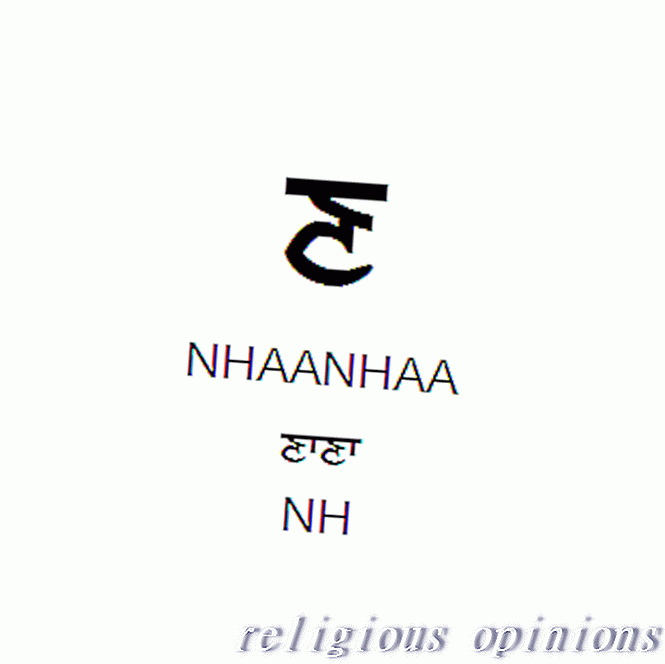 Punjabi Akhar Nhaanhaa Significance in Sikh Scripture Gurmukhi Script Nhaanhaa. Zdjęcie [S Khalsa]
Punjabi Akhar Nhaanhaa Significance in Sikh Scripture Gurmukhi Script Nhaanhaa. Zdjęcie [S Khalsa] Nhaanhaa of the Gurmukhi alphabet.
Nh - Gurmukhi Nhaanhaa Pronunciation Guide
Nhaanhaa is a consonant of the 35 Gurmukhi akhar of Gurbani and is identical to the Punjabi alphabet.
Nhaanhaa is represented by Nh or a double NN has the sound of N as in burn. Nhaanhaa is said with emphasis equally on both syllables as in Na-na, and is pronounced with the tongue curled back to touch the roof of the mouth so that when spoken there is a slight puff of air when the hand is held in front of the lips. The Romanized spelling of Nhaanhaa is phonetic and may also appear spelled as Nanna . Spellings may also differ slightly in original Gurmukhi as well as Romanized and English translations of Gurbani.
Significance of Nhaanhaa in Sikh Scripture
An acrostic form of poetic verse written by First Guru Nanak as a young boy when given a homework assignment in school by his teacher to write the alphabet expresses the spritual acheivement of conquering ego:
" Naanai ravat rehai ghatt antar har gun gaavai soee ||
NANNA: One whose inner being is filled with the Lord, sings His glorious praise." SGGS||433
Other acrostic verses featuring Nhaanhaa composed by various authors of Gurbani include:
" Naanaa ran tae seejhee-ai aatam jeetai koe ||
NANNA: One who conquers their own being, wins the battle of life." SGGS||256 Fifth Guru Arjan Dev
" Naanaa ran rootou nar nehee karai ||
NANNA: The warrior who fights on the battle-field should keep up and press on." SGGS||340 Bhagat Kabir
Gurmukhi Alphabet Tataa of Gurbani Illustrated With Pronunciation
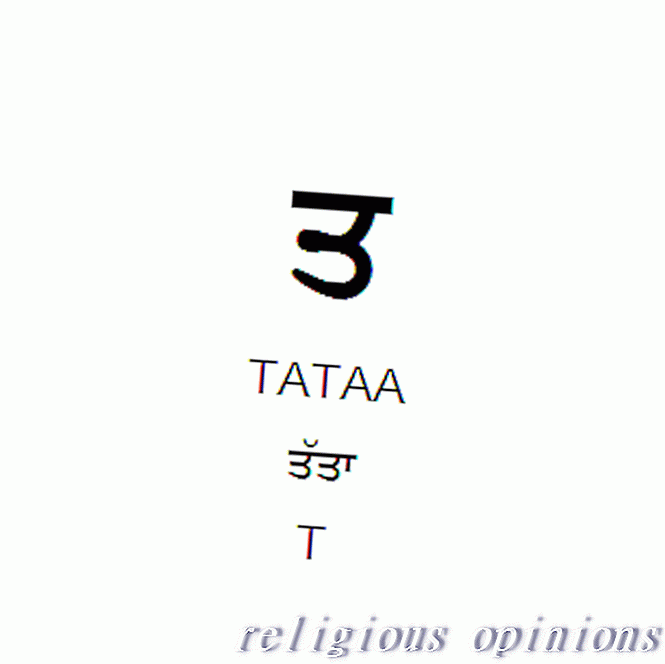 Punjabi Akhar Tataa Significance in Sikh Scripture Gurmukhi Script Tataa. Zdjęcie [S Khalsa]
Punjabi Akhar Tataa Significance in Sikh Scripture Gurmukhi Script Tataa. Zdjęcie [S Khalsa] Tataa is a consonant of the Gurmukhi alphabet.
T - Gurmukhi Tataa Pronunciation Guide
Tataa is a consonant of the 35 Gurmukhi akhar of Gurbani and is identical to the Punjabi alphabet.
Tataa represents the sound of T sounds and is said like ta-taw, with emphasis on the second syllable, and is pronounced with the tongue pressed against the back of the upper teeth. No air is felt when the hand is held in front of the lips. The Romanized spelling of Tataa is phonetic and may also appear spelled as Tatta . Spellings may differ slightly in original Gurmukhi as well as Romanized and English translations of Gurbani.
Significance of Tataa in Sikh Scripture
The scripture of Guru Granth Sahib includes an acrostic form of poetic verse of spritual signifigance written by First Guru Nanak as a young boy:
" Tatai taaroo bhavajal hoaa taa kaa ant na paa-i-aa ||
TATTA: So deep is the terrible world-ocean, its limits cannot be found." SGGS||433
Other acrostic verses of spirtual signifigance featuring Tataa written by the authors of Gurbabi include:
" Tataa taa sio preet kar gun nidh gobid ra-ae ||
TATTA: Enshrine love for that Treasure of Excellence who is the Universal Sovereign Lord." SGGS||256 Fifth Guru Arjan Dev
" Tataa atar tario-oo neh jaa-ee ||
TATTA: The treacherous world-ocean cannot be crossed over." SGGS||341 Bhagat Kabir
Gurmukhi Thathaa of Gurbani Alphabet Illustrated With Pronunciation
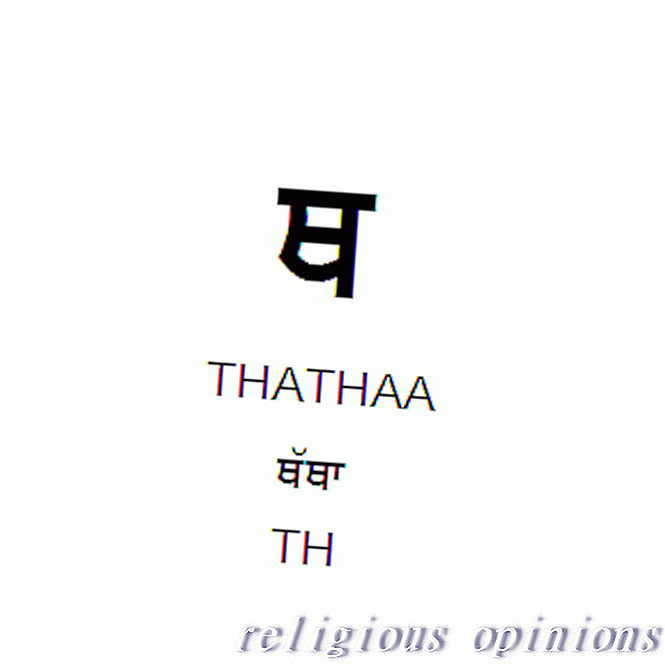 Punjabi Akhar Thathaa Significance in Sikh Scripture Gurmukhi Script Thathaa. Zdjęcie [S Khalsa]
Punjabi Akhar Thathaa Significance in Sikh Scripture Gurmukhi Script Thathaa. Zdjęcie [S Khalsa] Thathaa is a consonant of the Gurmukhi alphabet.
TH - Gurmukhi Thathaa Pronunciation Guide
Thathaa is a consonant of the 35 Gurmukhi akhar and is identical to the Punjabi paintee alphabet.
Thathaa represents the sound of TH as in teeth, is said like Tha-thaw with emphasis on the second syllable, and is pronounced with the tongue pressed behind the upper teeth so that a puff of air is felt when the hand is held in front of the lips. The Romanized spelling of Thathaa is phonetic and may also appear spelled as Thattha . Spellings also may differ slightly in original Gurmukhi as well as Romanized and English translations of Gurbani.
Significance of Thathaa in Sikh Scripture
As a young boy Guru Nanak surpised his teachers when he wrote a form of acrostic poetry with profound spirtual signifigance:
" Thathai thaan thaanntar so-ee jaa kaa kee-aa sabh ho-aa ||
THATHA: In all the places and interspaces is He, everything which exists is His doing." SGGS||433
Other signifigant acrostic verses using Thathaa composed by the authors of Guru Granth Sahib include:
" Thathaa thir ko-o-oo nehee kaa-e pasaarhu paav ||
THATHA: Nothing is permanent, why do you stretch out your feet?" SGGS||257 Guru Arjun Dev
" Thathaa athaah thaah nehee paavaa ||
THATHA: He is Unfathomable, His depths cannot be explored." SGGS||342 Bhagat Kabir
Gurmukhi Alphabet Dadaa of Gurbani Illustrated With Pronunciation
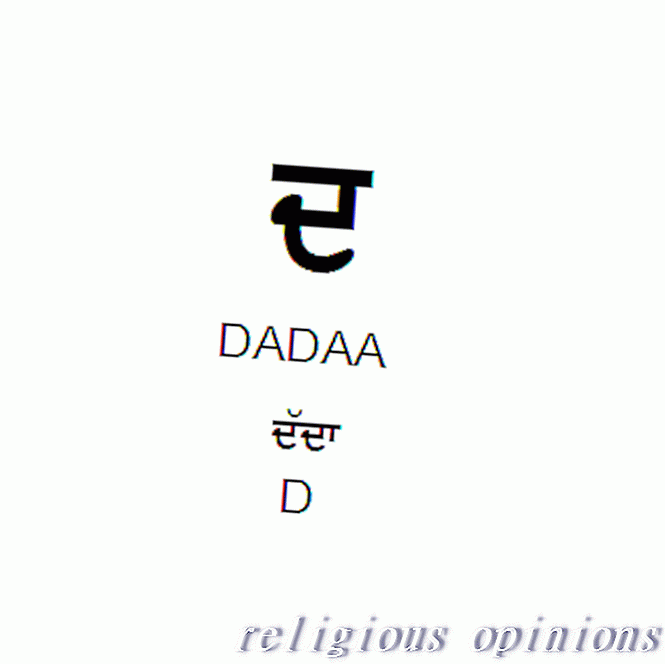 Punjabi Akhar Dadaa Significance in Sikh Scripture Gurmukhi Script Dadaa. Zdjęcie [S Khalsa]
Punjabi Akhar Dadaa Significance in Sikh Scripture Gurmukhi Script Dadaa. Zdjęcie [S Khalsa] Dadaa is a consonant of the Gurmukhi alphabet.
D - Gurmukhi Dadaa Pronunciation Guide
Dadaa is a consonant of the 35 Gurmukhi akhar of Gurbani and is identical to the Punjabi paintee alphabet.
Dadaa is pronounced as da-daw, with emphasis on the second syllable. The D sound is made with the tongue pressed against the back of the upper teeth. There should be no puff of air when when the hand is held in front of the lips. The Romanized spelling of Dadaa is phonetic and may also appear spelled as Dadda . Spellings may differ slightly in original Gurmukhi as well as Romanized and English translations of Gurbani.
Significance of Dadaa in Sikh Scripture
Sikh scripture includes poetic verse featuring akhar consonant Dadaa of Gurmukhi alphabet and appears throughout the Guru Granth Sahib.
A spiritual acrostic by Guru Nanak, first of the Sikh gurus, astonished his instructors when the juvinile pupil responded to an assignment with:
" Dadai dos na dae-oo kisai dos karnmaa aapn-i-aa ||
DADDA: Do not blame anyone else, the fault is of your own doing." SGGS||433
Acrostic Gurbani verses by other authors include:
" Dadaa daataa ae-ek hai sabh ko daevanhaar ||
DADDA: The great giver is the One all bestowing Lord." SGGS||257 Guru Arjun Dev
" Dadaa daekh ju binsanhaaraa ||
DADDA: Whatever can be seen is perishable." SGGS ||341 Bhagat Kabir
Gurmukhi Alphabet Dhadhaa of Gurbani Illustrated With Pronunciation
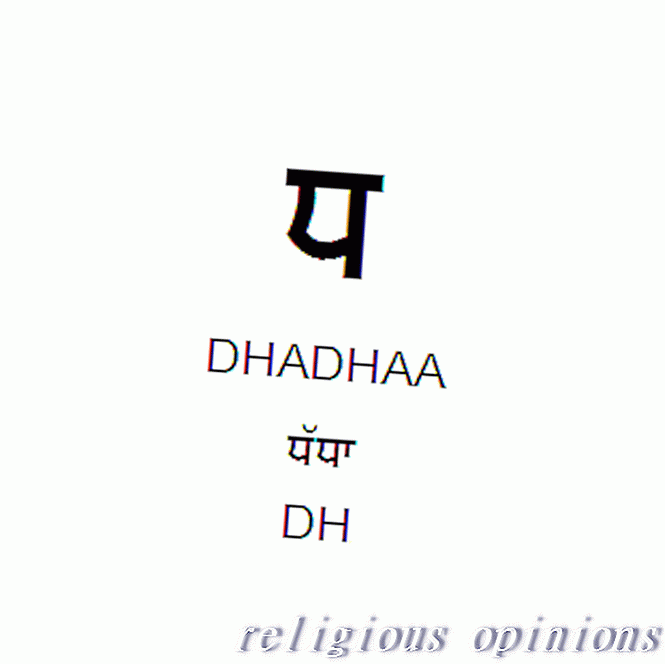 Punjabi Akhar Dhadhaa Significance in Sikh Scripture Gurmukhi Script Dhadhaa. Zdjęcie [S Khalsa]
Punjabi Akhar Dhadhaa Significance in Sikh Scripture Gurmukhi Script Dhadhaa. Zdjęcie [S Khalsa] Dhadhaa is a consonant of the Gurmukhi alphabet.
DH - Gurmukhi Dhadhaa Pronunciation Guide
Dhadhaa is a consonant of the 35 Gurmukhi akhar of Gurbani and identical to the Punjabi alphabet.
Dhadhaa represents an DH sound as in Dha-dhaw with emphasis on the second syllable and is pronounced with the tongue pressed against the back of the upper teeth so that when spoken there is a puff of air felt when the hand is held in front of the lips. The Romanized spelling of Dhadhaa is phonetic and may also appear spelled as Dhadha . Spellings may differ slightly in original Gurmukhi as well as Romanized and English translations of Gurbani.
Significance of Dhadhaa in Sikh Scripture
Guru Granth Sahib scripture includes acrostic form of poetic verse written by first Guru Nanak as a young boy. The lad amazed his teacher who teacher expressed astonishment when the child Nanak Dev wrote:
" Dhadhai dhaar kalaa jin chhoddee har cheejee jin rang kee-aa ||
DHADHA: The earth has been established and upheld by the Lord who has imparted His coloring to everything." SGGS||433
" Dhadhai dharam dharae dharmaa pur gunkaaree man dheeraa ||
DHADHA: Those who enshrine devotion dwell in the city of faith are the worthy ones whose minds are steadfast and stable.
Dhadhhai dhool parrai mukh mastak kanchan bha-ae manooraa ||
DHADHA: The dust of such saints' feet alighting upon one's face and forehead, transforms that one from iron to gold." SGGS||930
Other acrostic verses in Gurbani featuring Dhadhaa includesignifigant shabads composed by:
Fifth Guru Arjan Dev:
" Dhadhaa dhoor puneet tere janoo-aa ||
DHADHA: The dust beneath the feet of the holy is sacred." SGGS||251
" Dhadhaa dhaavat tou mittai santsang ho-e baas ||
DHADHA: Wanderings cease when one attains an abode in the Saint's association." SGGS||257
Bhagat Kabir:
" Dhadhaa aradheh ouradh nibaeraa ||
DHADHA: Everything is resolved when one turns about and ascends from the lower realms of earth to the higher realms of heaven." Kabir SGGS||341
Third Guru Amar Das:
" Dhadhai dhaavat varaj rakh moorrae antar terai nidhaan pa-i-aa ||
DHADHA: Restrain your wanderings O fool, within you is found the treasure." SGGS||435
Gurmukhi Alphabet Nanaa of Gurbani Illustrated With Pronunciation
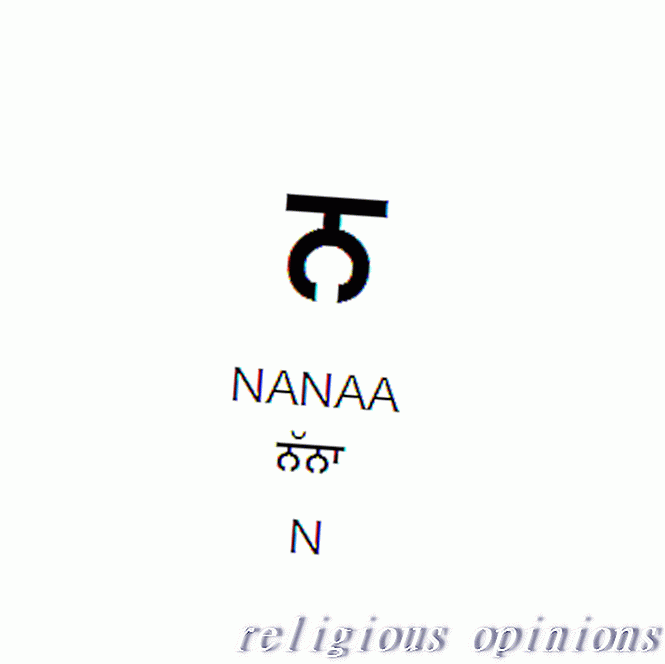 Punjabi Akhar Nanaa Significance in Sikh Scripture Gurmukhi Script Nanaa. Zdjęcie [S Khalsa]
Punjabi Akhar Nanaa Significance in Sikh Scripture Gurmukhi Script Nanaa. Zdjęcie [S Khalsa] Nanaa is a consonant of the Gurmukhi alphabet.
N - Gurmukhi Nanaa Pronunciation Guide
Nanaa is a consonant of the 35 Gurmukhi akhar of Gurbani and is identical to the Punjabi alphabet.
Nanaa represents an N sound as in na-naw with emphasis on the second syllable and is pronounced so that the tongue touches the back of the upper teeth. There should be no puff of air when the hand is held in front of the lips. The Romanized spelling of Nanaa is phonetic and may also appear spelled as Nannaa . Spellings may differ slightly in original Gurmukhi as well as Romanized and English translations.
Significance of Nanaa in Sikh Scripture
Sikh scripture includes acrostic form of poetic verse written by first Guru Nanak as a young boy when given a homework assignment in school by his teacher to write the alphabet. His teacher expressed astonishment when the child Nanak Dev wrote:
" Nannai naah bhog nit bhogai naa ddeethhaa naa sanmhaliaa ||
NANNA: The Husband Lord enjoys ever the pleasures, but is neither seen nor understood." SGGS||433
Other acrostic style shabads featuring Nanaa by the authors of Guru Granth Sahib include:
Fifth Guru Arjan Dev:
" Nannaa narak pareh tae naahee ||
NANNA: Into Narak (hell) they fall not." SGGS||257
" Sidhhan-ngaa-i-ai simareh naahee nannai naa tudh naam la-i-aa ||
Sidhan, Ngaayiyai: You remember Him not, NANNA: nor do you indulge in His name." SGGS||434
Bhagat Kabir:
" Nannaa nis din nirakhat jaaee ||
NANNA: The nights and days go by while I pass them looking for the Lord." Kabir SGGS||340
Gurmukhi Alphabet Papaa of Gurbani Illustrated With Pronunciation
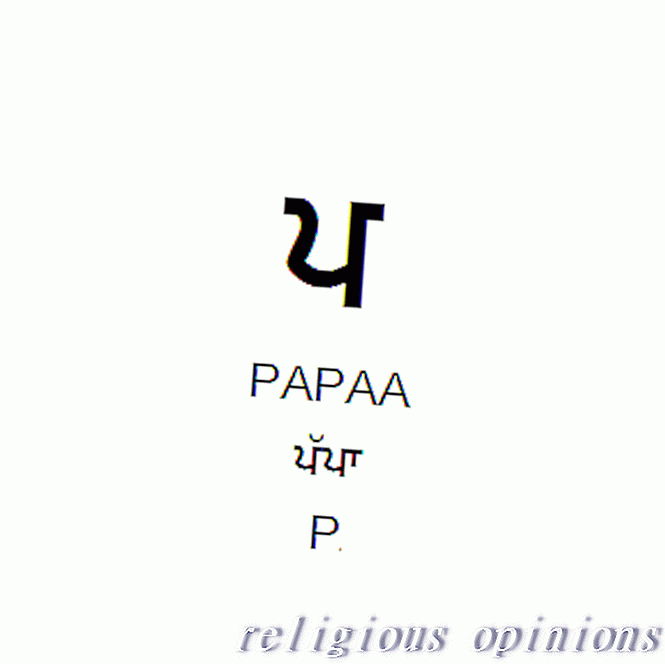 Punjabi Akhar Papaa Significance in Sikh Scripture Gurmukhi Script Papaa. Zdjęcie [S Khalsa]
Punjabi Akhar Papaa Significance in Sikh Scripture Gurmukhi Script Papaa. Zdjęcie [S Khalsa] Papaa is a consonant of the Gurmukhi alphabet.
P - Gurmukhi Papaa Pronunciation Guide
Papaa is a consonant of the 3k akhar of Gurmukhi script and is identical to the Punjabi alphabet.
Papaa is represented by P and pronounced as pa-paw, with emphasis on the second syllable. The lips must first be pressed together then open to form the sound of Pa. There should be no puff of air when when the hand is held in front of the lips as Papaa is spoken. The Romanized spelling of Papaa is phonetic and may also appear spelled as Pappa . Spellings may differ slightly in original Gurmukhi as well as Romanized and English translations of Gurbani.
Significance of Papaa in Sikh Scripture
Sikh scripture includes acrostic poetic verses featuring Gurmukhi consonant Papaa in the shabads of Gurbani.
When writing verses Guru Nanak, first of the Sikh gurus, astonished his instructors as a young boy with his spiritual insights:
" Papai paatisaahu parmaesar vaekhann ko parpanch kee-aa ||
PAPPA: The Supreme King and Transcendent Lord created the world and watches over it." SGGS||433
Other acrostic verses in Guru Granth Sahib by various authors of Gurbani include:
" Papaa parmit paar na paa-i-aa ||
PAPPA: He is beyond estimating, His limits cannot be discovered." SGGS||258 Fifth Guru Arjan Dev
" Papaa apar paar nehee paavaa ||
PAPPA: He is boundless his boundaries can never be known." SGGS||341 Bhagat Kabir
" Papai paar na pavehee moorrae parpanch toon palach rehiaa ||
PAPPA: You shall not swim across, O fool, as you are engrossed in worldly affairs." SGGS||435 Third Guru Amar Das
Gurmukhi Alphabet Phaphaa of Gurbani Illustrated With Pronunciation
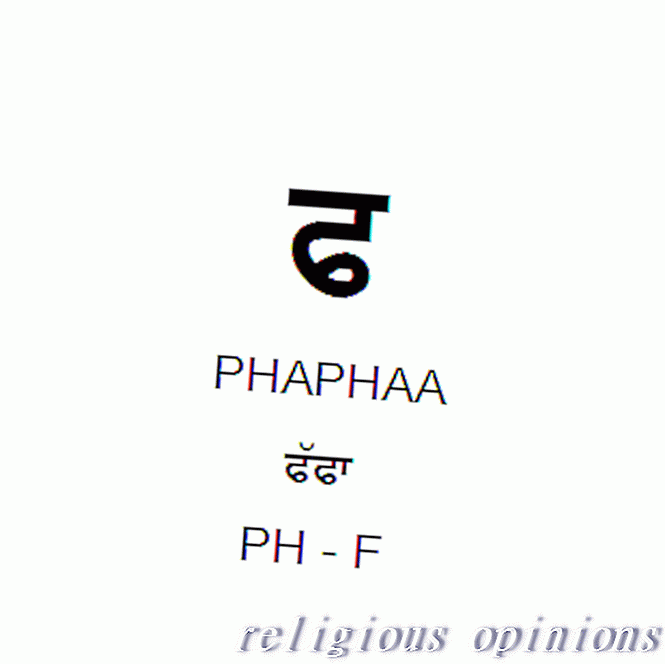 Punjabi Akhar Phaphaa Significance in Sikh Scripture Gurmukhi Script Phaphaa. Zdjęcie [S Khalsa]
Punjabi Akhar Phaphaa Significance in Sikh Scripture Gurmukhi Script Phaphaa. Zdjęcie [S Khalsa] Phaphaa is a consonant of the Gurmukhi alphabet.
Ph - Gurmukhi Phaphaa Pronunciation Guide
Phaphaa is a consonant of the 35 akhar of Gurmukhi script and is identical to the Punjabi alphabet.
Phaphaa is represented by PH as in elephant and is pronounced as pha-phaw, with emphasis on the second syllable. The Romanized spelling of Phaphaa is phonetic and may also appear spelled as Phapha and occasionally F is or Faffa is used, however PH is more correct as the sound is fully aspirated. Note the difference between saying fork and elephant or phosphorous while holding the hands to the lips. The lips must first be pressed together and then open to make the sound. A distinct puff of air should be felt when said while holding the hand in front of the lips. Spellings may also differ slightly in original Gurmukhi as well as Romanized and English translations of Gurbani.
Significance of Phaphaa in Sikh Scripture
Sikh scripture includes the acrostic form of poetic verse featuring Phaphaa of the Gurmukhi alphabet and appears throughout the Guru Granth Sahib.
As a child, Guru Nanak, the first Sikh guru, astonished his instructors when he presented them with an alphabetical spiritual acrostic:
" Phaphai phaahee sabh jag phaasaa jam kai sangal bandh la-i-aa ||
PHAPHA: The whole world is entangled in the noose of Death, and bound by its chains." SGGS||433
Acrostic verses by other authors of Gurbani featuring Phaphaa include:
" Phaphaa phirat phirat too aa-i-aa ||
PHAPHA: After wandering and wandering, at long last you have come." SGGS||258 Fifth Guru Arjan Dev
" Phaphaa bin phooleh phal ho-ee ||
PHAPHA: Without flowering, the fruit is produced." SGGS||340 Bhagat Kabir
Gurmukhi Alphabet Babaa of Gurbani Illustrated With Pronunciation
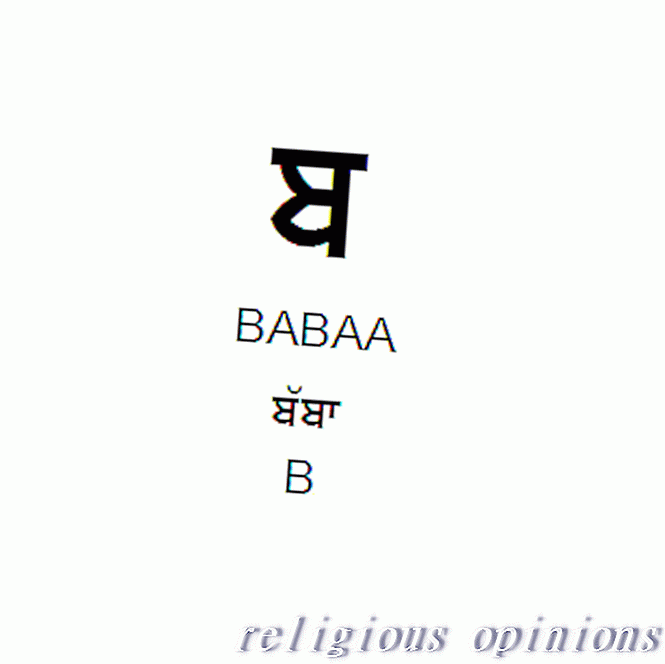 Punjabi Akhar Babaa Significance in Sikh Scripture Gurmukhi Script Babaa. Zdjęcie [S Khalsa]
Punjabi Akhar Babaa Significance in Sikh Scripture Gurmukhi Script Babaa. Zdjęcie [S Khalsa] Babaa is a consonant of the Gurmukhi alphabet.
B - Gurmukhi Babaa Pronunciation Guide
Babaa is a consonant of the Gurmukhi 35 akhar and is the same as the Punjabi alphabet.
Babaa is represented by B and pronounced as ba-baw, with emphasis on the second syllable. The lips must first be pressed together then open to form the sound of Ba. There should be no puff of air when when the hand is held in front of the lips. The Romanized spelling of is phonetic and may also appear spelled as Babba . Spellings may differ slightly in original Gurmukhi as well as Romanized and English translations of Gurbani.
Significance of Babaa in Sikh Scripture
Sikh scripture includes a form of poetic verse appearing the Guru Granth Sahib that features the Babaa character of the Gurmukhi alphabet.
Guru Nanak, the first Sikh guru, greatly impressed his tutpor when as a young boy he composed a spiritual acrostic:
" Babai baajee khaelan laagaa chouparr keetae chaar jugaa ||
Babba: He began to play the game, using as His dice-cloth, the four ages." SGGS||433
Various authors also composed acrostic verses of Gurbani featuring Babaa including:
" Babaa breham jaanat tae brehmaa ||
BABBA: One who divines (intuitively comes to know) the Supreme Divine is known as a Brahmin." SGGS||258 Fifth Guru Arjun Dev
" Babaa bindeh bind milaavaa ||
BABBA: The drip and drop blend together." SGGS||340 Bhagat Kabir
" Babai boojheh naahee moorrae bharam bhulae teraa janam ga-i-aa ||
BABBA: You understand not O fool, deluded by doubt your life wastes away." SGGS||434 Third Guru Amar Das
Gurmukhi Alphabet Bhabhaa of Gurbani Illustrated With Pronunciation
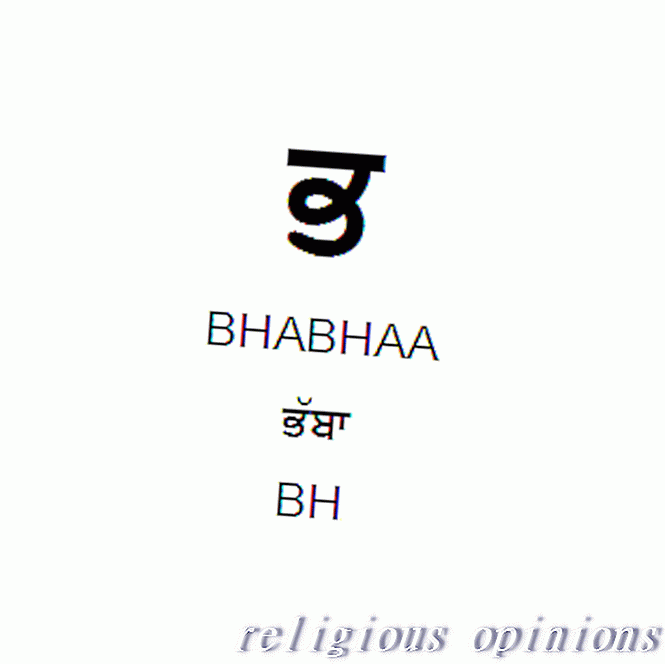 Punjabi Akhar Bhabhaa Significance in Sikh Scripture Gurmukhi Script Bhabhaa. Zdjęcie [S Khalsa]
Punjabi Akhar Bhabhaa Significance in Sikh Scripture Gurmukhi Script Bhabhaa. Zdjęcie [S Khalsa] Bhabhaa is a consonant of the Gurmukhi alphabet.
BH- Gurmukhi Bhabhaa Pronunciation Guide
Bhabhaa is a consonant of the Gurmukhi script 35 Akhar and is the same as that of the Punjabi alphabet.
Bhabhaa is pronounced as bha-bhaw, with emphasis on the second syllable. The lips must first be pressed together and then open to make the sound. The Romanized spelling of Bhabhaa is phonetic and may also appear spelled as Bhabha . Spellings may also differ slightly in original Gurmukhi as well as Romanized and English translations of Gurbani. For Romanized transliteration purposes in Gurbani scripture, Bhabhaa is most often represented by BH but sometimes is written as P for non scriptural purposes when writing Romanized Punjabi, because as in the English way of saying P, a distinct puff of air should be felt when the hand is held in front of the lips. For example the Punjabi word word for sister might be spelled Bhainji or Penji in Roman letters.
Significance of Bhabhaa in Sikh Scripture
Sikh scripture includes the acrostic form of poetic verse featuring Bhabhaa of the Gurmukhi alphabet and appears throughout the Guru Granth Sahib.
Guru Nanak Dev, first of the Sikh gurus, astonished his instructors when as a young boy given a homework assignment in school to write the alphabet, the child responded with a spiritual acrostic:
" Bhabhai bhaaleh se phal paaveh gur parsaadee jinh ko bho pa-i-aa ||
BHABHA: Those who seek are fruitful by the Enlightener's grace, and they become God-fearing." SGGS||434
Other signifigant acrostic shabads by various authors of Guru Granth Sahib include:
" Bhabhaa bharam mittaavhu apanaa ||
BHABHA: Cast off your doubt." SGGS||258 Fifth Guru Arjan Dev
" Bhabhaa bhaedeh bhaed milaavaa ||
BHABHA: Dispelling doubt divine union is achieved." SGGS||342 Bhagat Kabir
" Bhabhai bhavjal ddubohu moorrae maa-i-aa vich galtaan bha-i-aa ||
BHABHA: You have drowned in the terrible world-ocean, O fool, while engrossed in Maya's illusory wealth." SGGS||435 Third Guru Amar Das
Gurmukhi Script Mamaa of Gurbani Illustrated With Pronunciation
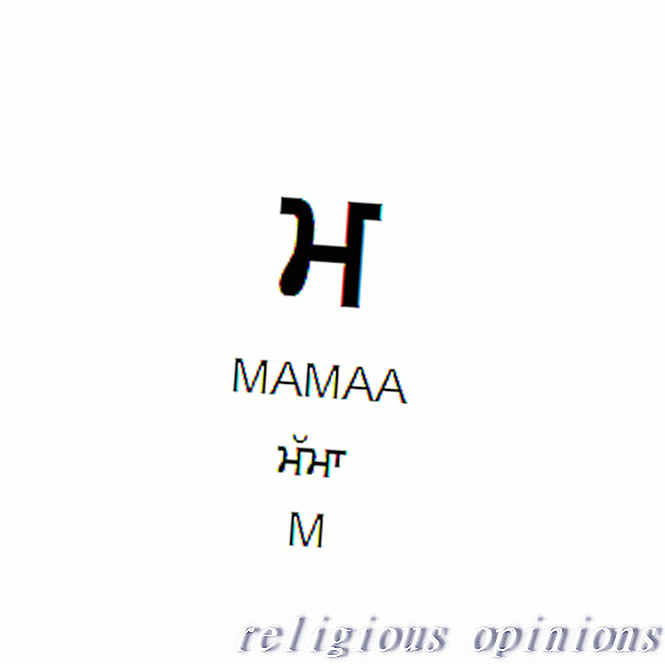 Punjabi Akhar Mamaa Significance in Sikh Scripture Gurmukhi Script Mamaa. Zdjęcie [S Khalsa]
Punjabi Akhar Mamaa Significance in Sikh Scripture Gurmukhi Script Mamaa. Zdjęcie [S Khalsa] Mamaa is a consonant of the Gurmukhi alphabet.
M - Gurmukhi Mamaa Pronunciation Guide
Mamaa is a consonant of the Gurmukhi script 35 akhar of Gurbani and is the same as its Punjabi alphabet counterpart.
Mamaa is represented by M and is pronounced as Ma-maw, with emphasis on the second syllable. The Romanized spelling of Mamaa is phonetic and may also appear spelled as Mamma . The lips must first be pressed together and then open to make the sound. No puff of air should be felt when said while holding the hand in front of the lips. Spellings may also differ slightly in original Gurmukhi as well as Romanized and English translations of Gurbani.
Significance of Mamaa in Sikh Scripture
Scripture of the Guru Granth Sahib includes poetic verses featuring Mamaa of the Gurmukhi alphabet. Teachers were wonderstruck when their student Guru Nanak, the first Sikh guru, presented them with a spiritual acrostic:
" Manmai mohu maran madhu-soodhan maran bha-i-aa tab chaetaviaa ||
Mamma: Attached to worldly love, only upon death does the mortal think of the Destroyer of Demon then dying God's (Immortal) Nectar is remembered." SGGS||434
Other verses featuring Mamaa in Gurbani include acrostic selections by authors:
Fifth Guru Arjun Dev:
" Mamaa maaganehaar i-aanaa ||
MAMMA: The poser is clueless." Guru Arjun Dev SGGS||258
" Mamaa jaahoo maram pachhaanaa ||
MAMMA: One having perception of divine mysteries." SGGS||259
Bhagat Kabir:
" Mamaa mool gehiaa man maanai ||
MAMMA: When its origin is adhered to the soul is satiated." SGGS||342
" Mamaa man sio kaaj hai man saadhae sidh ho-e ||
MAMMA: The mind is busily pre-occupied, the mind when disciplined attains perfection." Kabir SGGS||342
Third Guru Amar Das:
" Manmai mat hir la-ee teree moorrae houmai vaddaa rog pa-i-aa ||
MAMMA: Your intellect has been plundered, O fool, pride has greatly afflicted you." SGGS||435
Gurmukhi Alphabet Yayaa of Gurbani Illustrated With Pronunciation
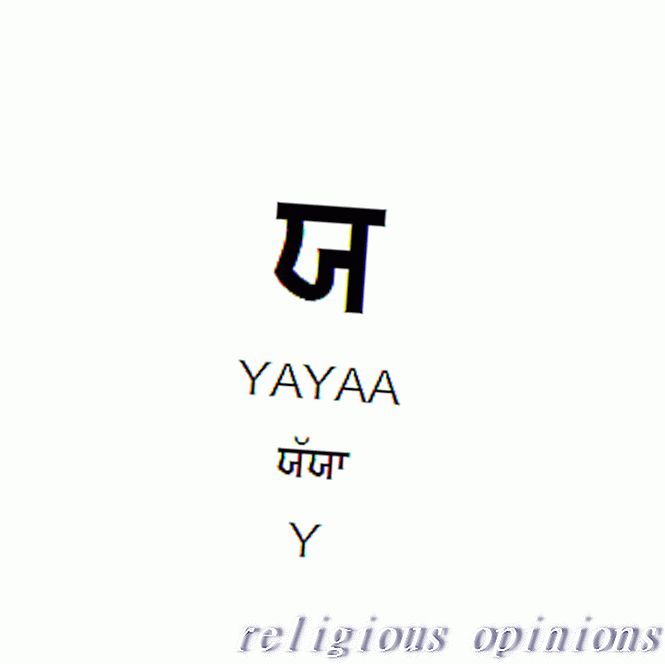 Punjabi Akhar Yayaa Significance in Sikh Scripture Gurmukhi Script Yayaa. Zdjęcie [S Khalsa]
Punjabi Akhar Yayaa Significance in Sikh Scripture Gurmukhi Script Yayaa. Zdjęcie [S Khalsa] Yayaa is a consonant of the Gurmukhi alphabet.
Y - Gurmukhi Yayaa Pronunciation Guide
Yayaa is a consonant of the 35 akhar Gurmukhi script of Gurbani and identical to its Punjabi alphabet counter part.
Yayaa is represented by Y and is pronounced as ya-yaw with the emphasis on the second syllable. The Romanized spelling of Yayaa is phonetic and may also appear spelled as Yayya . Spellings may differ slightly in original Gurmukhi as well as Romanized and English translations of Gurbani.
Significance of Yayaa in Sikh Scripture
Guru Nanak the first Sikh guru Sikh composed acrostic hymns featuring Yayaa as a young student:
" Yayai janam na hovee kad hee je kar sach pachhaannai ||
YAYYA: Birth is not taken again by one who realizes the True Lord." SGGS||434
Fifth Guru Arjan Dev also composed similar style alphabetical acrostic shabads:
" Yayaa jaaro duramat do-oo ||
YAYYA: Burn away the egoistic toughts of double-mindedness.
Tiseh tiaag sukh sehajae so-oo ||
Relinquish them and sleep peacefully in equipoise.
Yayaa jaa-e parhu sant sarnaa ||
YAYYA: Go seek refuge of the Saints.
Jeh aasar e-aa bhavjal taranaa ||
With their help, the terrible world-ocean is crossed over.
" Yayaa janam na aavai so-oo ||
YAYYA: Birth is not taken again.
Ek naam lae maneh paro-oo ||
When the One name is taken with in the heart.
Yayaa janam na haaree-ai gur poorae kee ttaek ||
YAYYA: This lifetime shall not be wasted, if one has support of the Pure Enlightener.
Naanak teh sukh paa-i-aa jaa kai hee-a-rai ek ||14||
O Nanak, One finds peace with one's heart heart on attaining the One Lord." ||14|| Guru Arjun Dev SGGS||253
" Yayaa jatan karat bahu bidhee-aa ||
YAYYA: People make efforts of may kinds.
Ek naam bin keh lo sidhee-aa ||
Without the One Name, how far can anyone succeed?" SGGS||259
Bhagat Kabir a 15th century saint composed hymns in the acrostic style as well:
" Yayaa jo jaaneh tou duramat han kar bas kaa-i-aa gaa-o ||
YAYYA: If you comprehend anything, then destroy your double-mindedness and subdue the body-village." SGGS||342
Gurmukhi Alphabet Raaraa of Gurbani Illustrated With Pronunciation
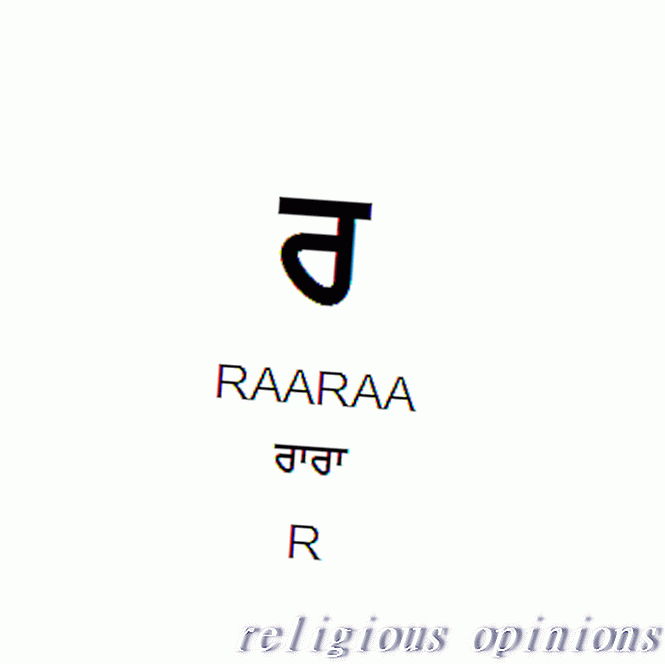 Punjabi Akhar Raaraa Significance in Sikh Scripture Gurmukhi Script Raaraa. Zdjęcie [S Khalsa]
Punjabi Akhar Raaraa Significance in Sikh Scripture Gurmukhi Script Raaraa. Zdjęcie [S Khalsa] Raaraa is a consonant of the Gurmukhi alphabet.
R - Gurmukhi Raaraa Pronunciation Guide
Raaraa is a consonant of the Gurmukhi script 35 akhar and identical to its Punjabi alphabet counterpart.
Raaraa is a symbol for R and is pronounced with the tongue forward, is rolled and sounds like are-rrr. Raaraa is phonetic and may also appear spelled as Rarra . Spellings may differ slightly in original Gurmukhi as well as Romanized and English translations of Gurbani.
Significance of Raaraa in Sikh Scripture
Sikh scripture of the Guru Granth Sahib includes the acrostic form of poetic verse featuring Raaraa of the Gurmukhi alphabet.
First Guru Nanak Dev, astonished his instructors when as a young boy given an assignment in school to write the alphabet, the child responded with a spiritual acrostic:
" Raarai rav rehiaa sabh antar jaetae kee-ae jantaa ||
RARRA: The Lord is contained among all beings He created." SGGS||434
Other authors of Guru Granth Sahib also composed signifigant alphabetical shabads in the acrostic style including:
Fifth Guru Arjan Dev:
" Raaraa rangahu iaa man apanaa ||
RARRA: Dye this thy heart with Love of the Lord." SGGS||252
" Raaraa raen hot sabh jaa kee ||
RARRA:Be the dust beneath the feet of all." SGGS||259
15th Century Saint Bhagat Kabir:
" Raaraa ras niras kar jaaniaa ||
RARRA: Worldly tastes I have found to be tasteless." SGGS||342
Third Guru Amar Das:
" Raarai raam chit kar moorrae hiradhai jinh kai rav rehiaa ||
RARRA: Remember the Lord and abide with those in whose heart he is ever present. SGGS||435
Gurmukhi Alphabet Lalaa of Gurbani Illustrated With Pronunciation
 Punjabi Akhar Lalaa Significance in Sikh Scripture Gurmukhi Script Lalaa. Zdjęcie [S Khalsa]
Punjabi Akhar Lalaa Significance in Sikh Scripture Gurmukhi Script Lalaa. Zdjęcie [S Khalsa] Lalaa is a consonant of the Gurmukhi alphabet.
L - Gurmukhi Lalla Pronunciation Guide
Lalaa is a consonant of the 35 akhar Gurmukhi script of and is identical to its Punjabi alphabet counterpart.
Lalaa has the sound of L and is pronounced with the emphasis on the second syllable like sa-saw. The Romanized spelling of Lalaa is phonetic and may also appear spelled as Lalla, or Lallaa . Spellings may differ slightly in original Gurmukhi as well as Romanized and English translations of Gurbani.
Significance of Lalaa in Sikh Scripture
Guru Granth Sahib scripture includes an acrostic form of alphabetical poetic hymns featuring the Gurmukhi consonant Lalaa .
The teacher expressed astonishment when as a young school boy First Guru Nanak Dev wrote:
" Lalai laa-e dhandhhai jin chhoddee meethhaa maa-i-aa mohu kee-aa ||
LALLA: He who assigned the created beings to their tasks, has made such illusory involvement seem sweet to them." SGGS||434
Fifth Guru Arjan Dev also composed alpabetical shabads featuring Lalaa including:
" Lalaa lapatt bikhai ras raatae ||
LALLA: Entangled, they are tainted by their taste for corrupt pleasures." SGGS||252
" Lalaa taa kai lavai na ko-oo ||
LALLA: Equal to Him, there is none." SGGS||252
" Lalaa laavo aoukhadh jaahoo ||
LALLA: Apply the medicine of God's name." SGGS||259
Bhagat Kabir also wrote featuring Lalaa in the acrostic style:
" Lalaa aisae liv man laavai ||
LALLA: Embrace devotional love and to your heart apply it" SGGS||342
Gurmukhi Alphabet Vaavaa of Gurbani Illustrated With Pronunciation
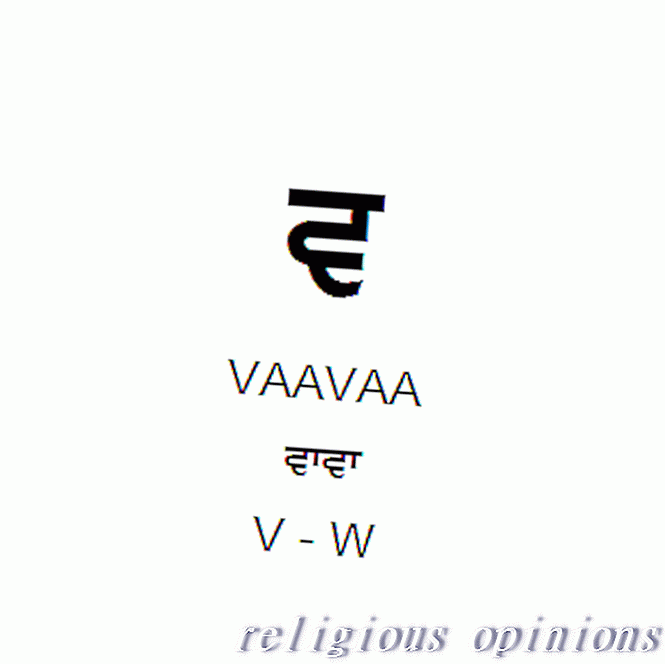 Punjabi Akhar Vaavaa Significance in Sikh Scripture Gurmukhi Script Vavaa. Zdjęcie [S Khalsa]
Punjabi Akhar Vaavaa Significance in Sikh Scripture Gurmukhi Script Vavaa. Zdjęcie [S Khalsa] Vaavaa is a consonant of the Gurmukhi alphabet.
V - Gurmukhi Vaavaa Pronunciation Guide
Vaavaa is a consonant of the 35 akhar Gurmukhi script of Gurbani and identical to its Punjabi alphabet counter part.
Vavaa may be represented by or V or W and is pronounced with the upper teeth touching the bottom lip with emphasis equally on both syllables so that it produces a sound between the English vaw-vaw and waw-waw. The Romanized spelling of Vaavaa is phonetic and may also appear spelled as Vava or Waawaa etc.. Care should be taken to produce the sound blending V or W which may sometimes be misrepresented or misprounounced by B such as commonly substituting the spelling of Baisakhi for Vaisakhi, though it is seldom, if ever, spelled Waisakhi . Spellings may also differ slightly in original Gurmukhi as well as Romanized and English translations of scripture of Gurbani. Words are to be pronounced as written in scripture, which is why it is important to learn to recognize Gurmukhi script. For example the following words have several ways of being spelled:
Bikram and Vikram are both common, though probably not Wikram .
Gobind is most common, but may also be spelled as Govind and even Gowind .
Significance of Vaavaa in Sikh Scripture
Sikh scripture includes several acrostic form of poetic verse featruing Vavaa written by various authors of Guru Granth Sahib:
First Guru Nanak Dev impressed his tutors with his spiritual outlook and insights when as a student he wrote:
" Vavai vaasudae-ou parmaesar vaekhann ko jin vaes kee-aa ||
WAWWA: The all-pervading Transcendent Master oversees the world having created the form it wears." Fiorst Guru Nanak Dev SGGS||434
Fifth Guru Arjan Dev framed spiritual lessons within his acrostic style shabad:
" Vavaa vair na karee-ai kaahoo ||
WAWWA: Harbor not hatred against anyone." Guru Arjun Dev SGGS||259
15th century saint and poet Bhagat Kabir wrote an alphabetical compostion featuring Vavaa:
" Vavaa baar baar bisan samhaar ||
WAWWA: Again and again, dwell upon the abode of the Lord Master." SGGS||342
Third Guru Amar Das also favored the acrostic style of alphabetical composition:
" Vavai vaaree aa-ee-aa moorrae vaasudae-o tudh veesar-i-aa ||
WAWWA: Your turn has come, O fool, but you have forgotten the Luminous Lord. SGGS||435
Gurmukhi Alphabet Rrarraa of Gurbani Illustrated With Pronunciation
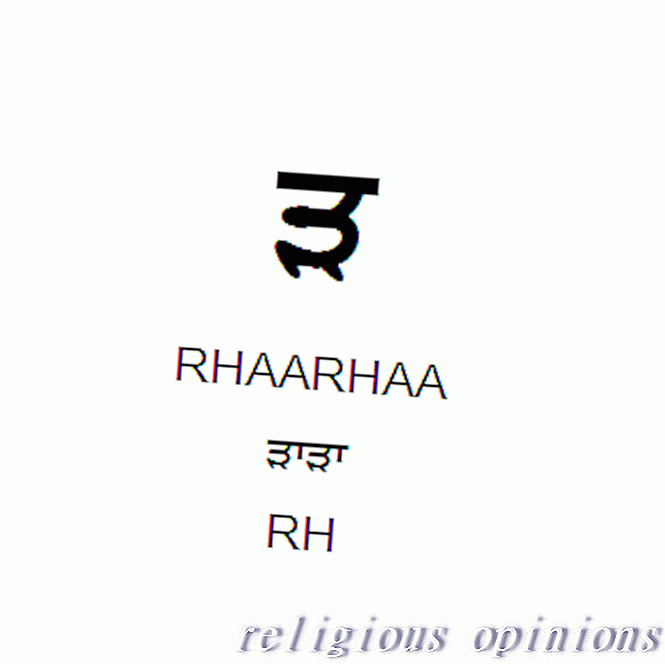 Punjabi Akhar Rrarraa Significance in Sikh Scripture Gurmukhi Script Rharhaa. Photo © [S Khalsa]
Punjabi Akhar Rrarraa Significance in Sikh Scripture Gurmukhi Script Rharhaa. Photo © [S Khalsa] Rrarraa is a consonant of the Gurmukhi alphabet
RR - Gurmukhi Rrarraa Pronunciation Guide
Rrarraa is a consonant of the 35 akhar Gurmukhi script featured in Gurbani and is identical to its Punjabi alphabet counterpart.
Rraarraa is pronounced with the tongue curled back to touch just behind the ridge at the roof of the mouth and sounds like ra. The Romanized spelling of Rraarraa is phonetic and may also appear spelled as Rhaarhaa . Other phonetic spellings may differ slightly in original Gurmukhi as well as Romanized and English translations of Gurbani depending on gramatical usage.
Significance of Rrarraa in Sikh Scripture
Several authors of Gurbani composed shabads in the acrostic style which feature the Gurmukhi consonant Rrarraa in Guru Granth Sahib scripture:
First Guru Nanak Dev showed his spiritual depth of character as a young student when we wrote:
" Rraarrai raarr kareh kiaa praanee tiseh dhiaavhu je amar hoaa ||
RRARRA: Why quarrel O mortal? Meditate on the imperishable Lord." SGGS||434
Fifth Guru Arjan Dev used various grammatical forms of Rrarraa in his acrostic shabad:
" Rraarraa rraar mittai sang sadhoo ||
RRARRA: Conflict is eliminated when associating with true the pious.
Karam dharam tat naam araadhoo ||
The essence of religious rites and creeds is meditation done in adoration of the Lord's Name.
Roorho jih basiou ridh maahee ||
In the heart of whom the Beauteous Lord abides,
Ouaa kee rraarr mittat binsaahee ||
Strife is erased, eliminated.
Rraarr karat saakat gaavaaraa ||
The opinionated argue foolishly in faithless disputes.
Jaeh heeai ahnbudh bikaaraa ||
Whose heart is filled with prideful intellect in ignorance bickers.
Rraarraa gurmukh rraarr mittaaee ||
RRARRA: Dispute is settled by the enlightened mouth which ceases to quarrel.
Nimakh maahe naanak samjhaaee ||47||
In an instant the Exalted instructor, O Nanak, is understood." SGGS||260
Gurmukhi Alphabet Ik Onkar of Gurbani Illustrated With Pronunciation
 Ik Onkar Significance in Sikh Scripture Ik OanKar. Photo © [S Khalsa]
Ik Onkar Significance in Sikh Scripture Ik OanKar. Photo © [S Khalsa] Ik Onkar is a combination character of the Gurmukhi Script.
Gurmukhi Pronunciation Guide to Ik Onkar
Ik Onkar is a combination character featuring the Gurmukhi numeral 1 and is symbolic of One Creator and Creation, in the verse Mool Mantar which appears at the very beginning of Gurbani, and throughout Sikh Scripture.
Ik Onkar is a phonetic spelling and may also be spelled Ik Oankar or Ek Onakaar . Broken into parts both word and symbol are correctly pronounced with stress on the vowels Ik-O-An-Kar:
Ik has a short i sound as in lick.
O has a long o sound as in oat.
An has short a sound like the u in un.
Kaar has a long aa sound as in car.
Significance of IK Onkar in Sikh Scripture
The character Ik Onkar, and the word Onkar, both signify in the scripture of Guru Granth Sahib and are featured together in the acrostic verses of poet Bhagat Kabir:
" Ik Onkar satnaam kartaa purkh gurprasaad ||
One creator at one with creation, a truly identifiable creative personalty, realized by the Enlightener's grace." SGGS||340
" Oankaar aad mai jaanaa ||
I know only the One Creative Original Being.
Likh ar maettai taa-eh na maanaa ||
What is written is also erased, I believe not in the perishable.
Oankaar lakhai jo koee ||
Creator and creation, behold them (as One).
So-ee lakh maettanaa na hoee ||6||
One seeing (and understanding) this, perishes not." ||6|| SGGS||340



